Paris Fashion Week A/W 2024: Chanel to Louis Vuitton
The best of Paris Fashion Week A/W 2024, from Chanel’s trip back to its beginnings in Deauville to a thrilling ten-year anniversary collection from Nicolas Ghesquière at Louis Vuitton
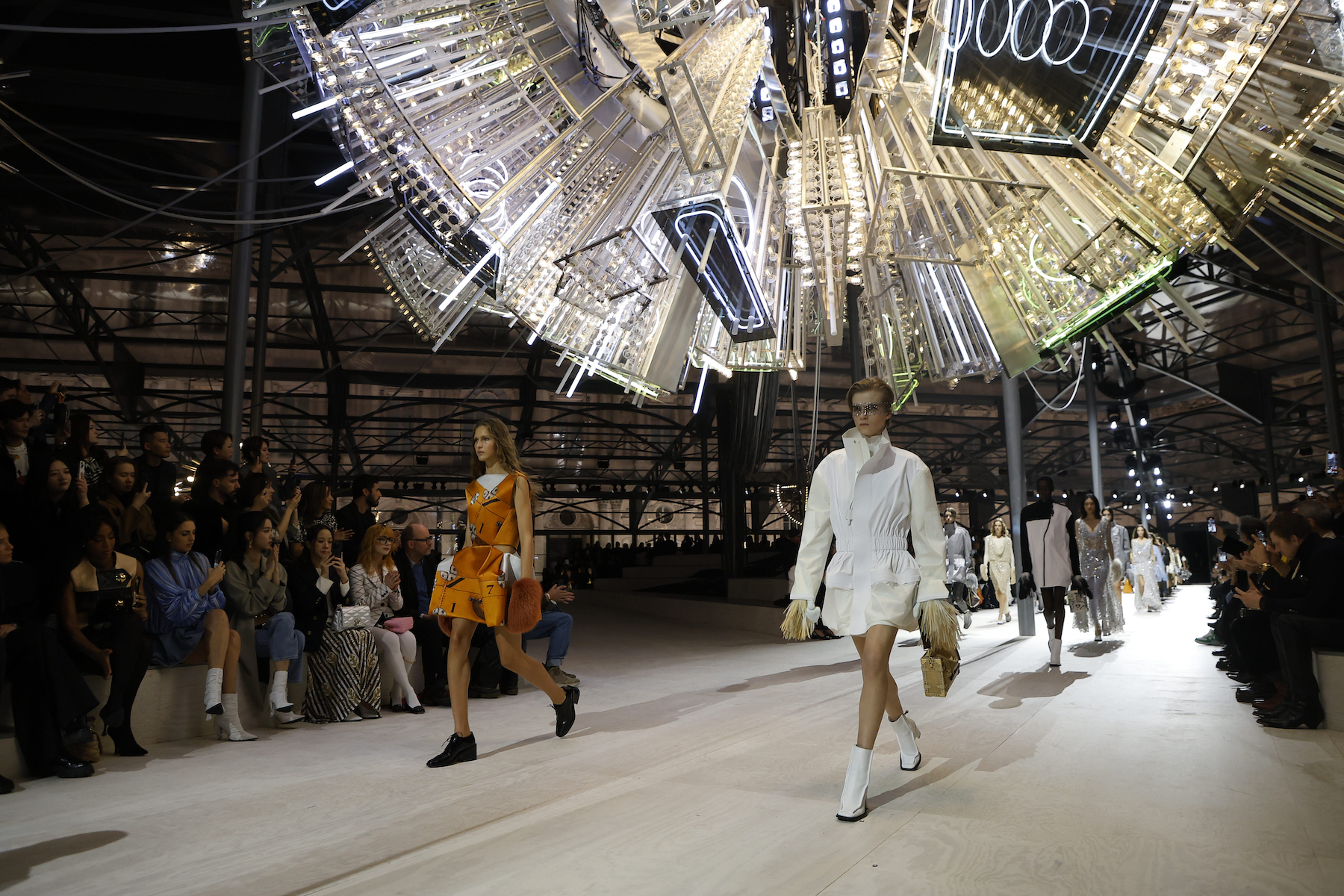
And so, after stops in Copenhagen, New York, London and Milan, Paris Fashion Week A/W 2024 marked the culmination of fashion month – a glittering nine-day finale that featured outings from the industry’s biggest names. These included Louis Vuitton, which closed the week on Tuesday evening (5 March), where creative director Nicolas Ghesquière celebrated ten years at the storied Parisian house in spectacular fashion.
Earlier in the week, Dior began proceedings with a collection that looked back to the house’s first-ever ready-to-wear collection, Miss Dior, which was launched in 1967. Backdropped by the sculptures of Indian artist Shakuntala Kulkarni, creative director Maria Grazia Chiuri said she wanted the collection to capture the era’s liberated femininity. Meanwhile, at Saint Laurent, a sensually charged show saw Anthony Vaccarello present an almost entirely sheer collection, inspired in part by Marilyn Monroe’s ‘naked dress’, which she wore for her final public appearance in 1962. Elsewhere, there was a ‘sensual and symmetrical’ collection from Nicolas di Felice at Courrèges, a full-throttle outing at Acne Studios, which clashed ‘elevated femininity and a biker attitude’, and riff on aristocratic dress codes by Jonathan Anderson at Loewe. Chemena Kamali also made her debut at Chloé, while Irish designer Seán McGirr presented his debut collection for Alexander McQueen, having taken over from Sarah Burton last September.
Here, Wallpaper* fashion features editor Jack Moss selects the shows to remember from Paris Fashion Week A/W 2024 (also see Wallpaper’s stand-out A/W 2024 beauty moments).
The best of Paris Fashion Week A/W 2024
Louis Vuitton
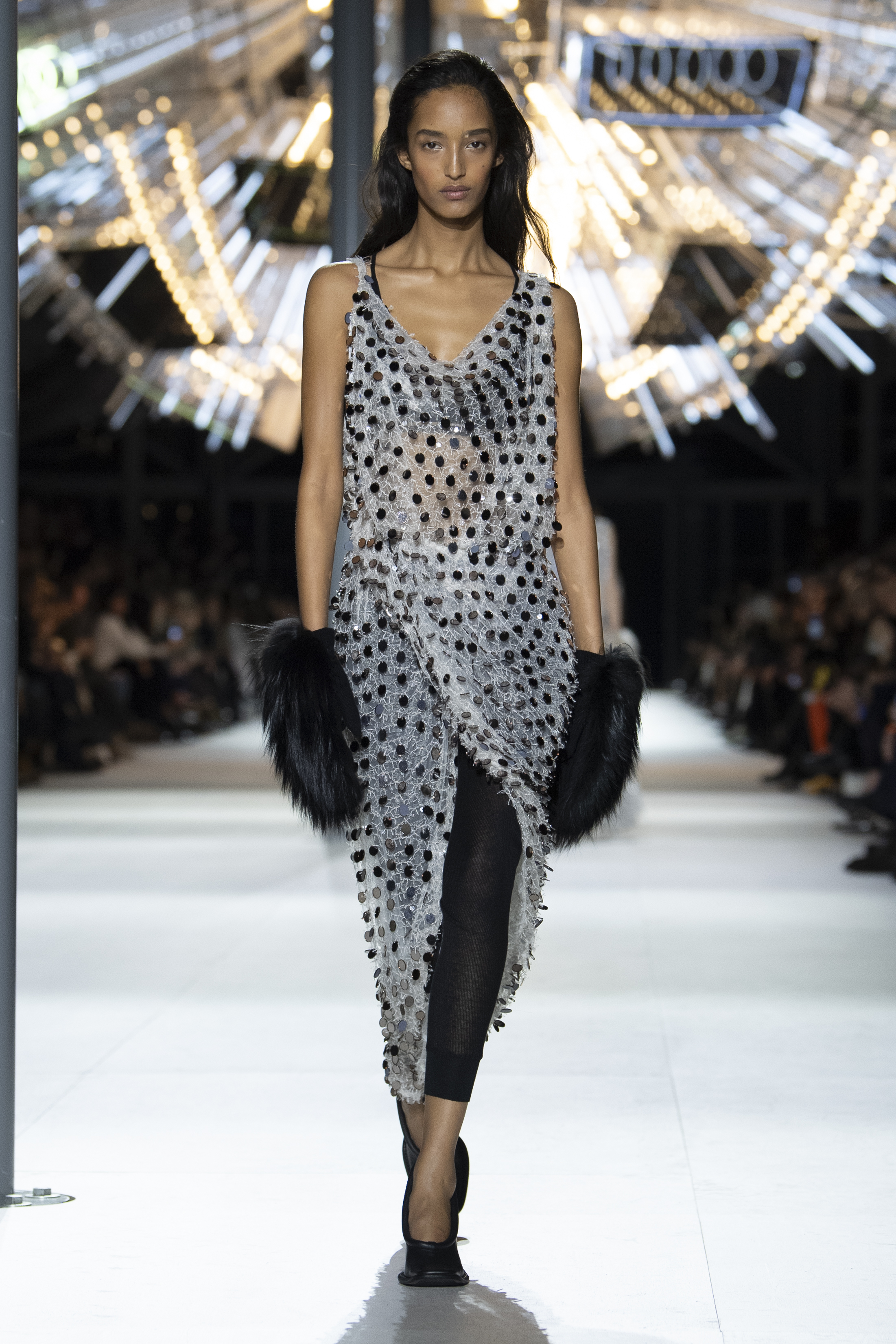
Louis Vuitton A/W 2024
Leave it to Nicolas Ghesquière to close out fashion week in spectacular fashion, celebrating ten years at Louis Vuitton with a thrilling collection that imagined his previous collections anew. In front of over 4,000 guests – including hundreds of Louis Vuitton staff invited for the occasion – it was a tour de force of design that cemented his legacy as perhaps his generation’s most influential designer.
The show took place in the Cour Carrée at the Louvre, the place where he showed his first collection in 2014. Then, enormous metal blinds opened to let in the sunlight to herald a new day; yesterday evening, the space was filled with a blockbuster set by artist Phillippe Parreno and film production designer James Chinlund, a series of light installations that centred around an enormous orb that flashed and sparked as the show began.
Each look in the collection, said Ghesquière, was based on a previous garment from the past decade, though here they had been reimagined in a way that the designer described as capturing ‘a tinge of earlier affinities, felicitous imprints of beloved garments, and affection for a gesture, a cut or an embroidery’. He also said that it was about ‘following one’s North Star’, a testament to Ghesquière’s unerring, recognisable vision, which is largely defined by a futuristic, postmodern approach which sees him traverse eras and cultural references in a sometimes dizzying manner.
What struck here, though, were the extraordinary moments of craft: fronds of feather-like tassels emerging from the cuff of sleek-lined parkas, shimmering swathes of clattering sequins, intricately embroidered brocade overcoats, or the billowing ruffled skirts edged with what looked like shards of silver confetti. Contrast came in sleek, moulded silhouettes, like a series of hourglass tailored jackets which felt quintessentially Ghesquière.
Receive our daily digest of inspiration, escapism and design stories from around the world direct to your inbox.
‘This is a particular evening, a meaningful evening,’ he wrote in a personal letter left on each attendee’s seat. ‘I remember the feeling of beginning, the immense joy to be among you. This joy is still here.’ As the audience rose to their feet for his final bow, it was palpable.
Chanel
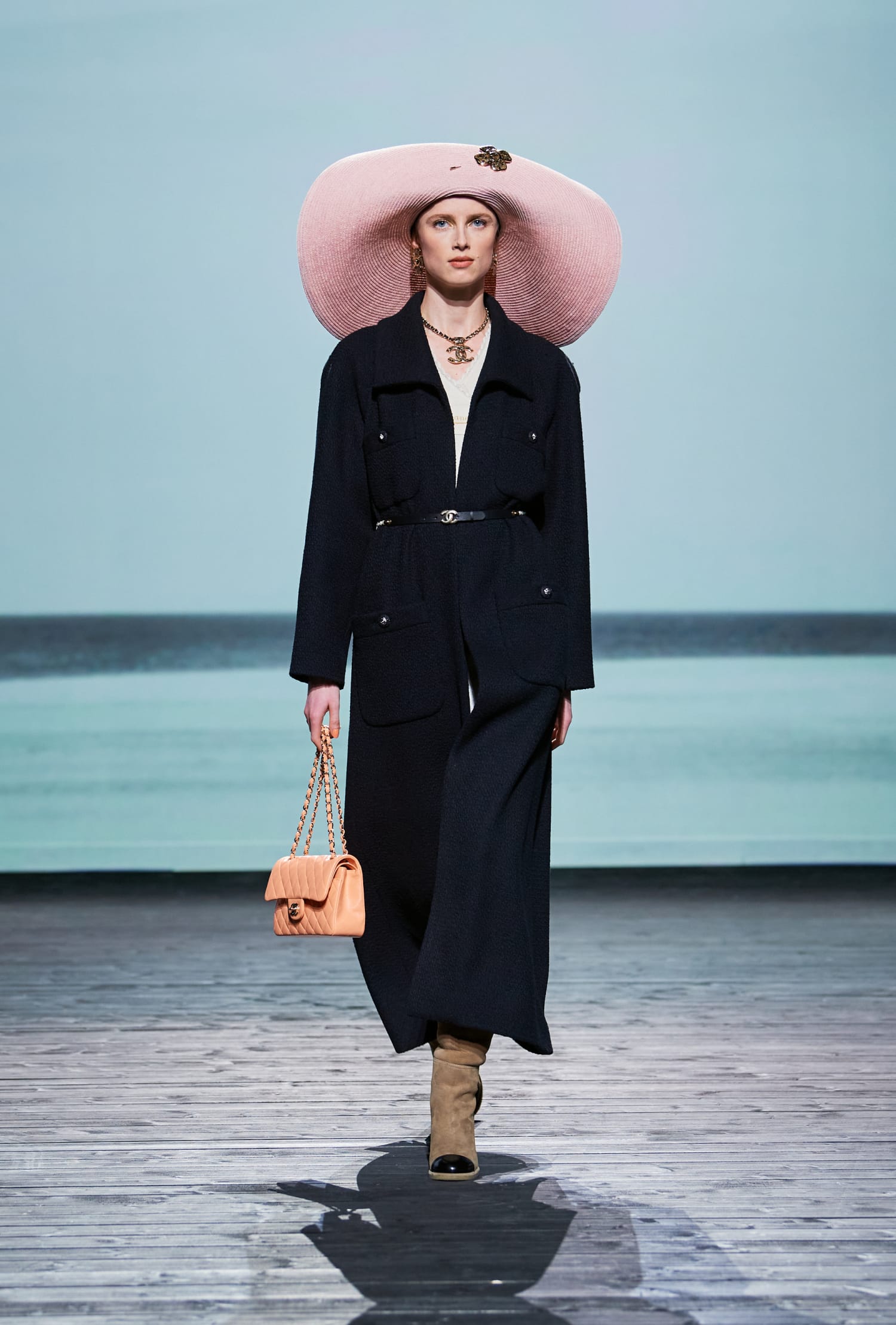
Chanel A/W 2024
Following the cinematic interludes of recent seasons, Virginie Viard’s latest collection began with an Inez & Vinoodh-shot short film starring Penelope Cruz and Brad Pitt as a pair of lovers on a beachside jaunt (a cameo came from the model and house muse Rianne Van Rompaey, who played the couple’s waitress). It was inspired, said Viard, by Claude Lelouch’s 1966 French film A Man and a Woman (Un homme et une femme), which is set partly in the Normandy beachside town of Deauville. Its links to the French house are multiple: A Man and a Woman’s titular ‘femme’ is actress Anouk Aimée, a close friend of house founder Gabrielle ‘Coco’ Chanel, while Deauville is where the couturier would start her eponymous house with a millinery shop that opened in 1912. ’It’s where it all began for Gabrielle Chanel,’ said Viard of Deauville, temporarily transforming the Grand Palais Éphémère into the town’s wooden boardwalk for the show. ’This story is very close to my heart.’
In the collection itself, Viard conjured the romance of a beachside town in winter, creating a collection of ‘warmth… of layers of materials, colours and volumes’. Long, sinuous overcoats in the house’s signature tweed were inspired by languid 1920s silhouettes, while chunky knitted skirts, cable-knit sweaters, and some brilliant shearling jackets (a nod, said Viard, to the 1970s) were befitting the autumn-winter season. Coated faded denim had an easy elegance, a mood continued in a series of diaphanous ruffled gowns that were printed with colourful illustrations of 35mm film and cinema tickets. But it was the enormous sun hats, pulled off the face with decorative hat pins, which provided the collection’s most memorable impression – a nod to the house’s millinery origins, and a symbolic link between Chanel and Viard, two designers working a century apart.
Miu Miu

Miu Miu A/W 2024
‘Every single morning, I decide if I’m going to be 15 years old, or a lady near death.’ So said Miuccia Prada on Tuesday afternoon after her latest Miu Miu show, which drew inspiration from ‘from the span and scope of people’s lives’ (a multi-generational cast, which included the 63-year-old actress Kristin Scott Thomas and 70-year-old doctor Qin Huilan, hammered home the message). It made for an eclectic collection – ‘a dichotomous mixing of different codifications of dress’ – which combined the liberated rebellion of childhood and youth with the ‘signifiers of propriety and chic’ that define adulthood. The former emerged in shrunken silhouettes, girlish round-toed Mary Janes, coloured tights, skinny jeans and stomach-bearing cropped denim jackets, the latter in ladylike twin sets, strings of pearls, brooches and bourgeois (faux) fur jackets. Other garments suggested a woman at work: baggy blue shirts and trousers recalled a doctor or nurse’s scrubs. Miuccia Prada explained, via the collection notes, that the shifting moods of the collection were built from a desire to alter the perception of Miu Miu, which has traditionally been seen as the girlish younger sister to a grown-up Prada. Here, the designer said she wanted to shift what such ‘girlishness’ means, blurring the divide between youth and age. ’[It’s] a word we can revalue, from a pejorative gendered noun, anchored to age, to a universal idiom expressive of the strength of rebellion, a spirit of freedom and individuality, one attribute of a richer whole.’
Rokh
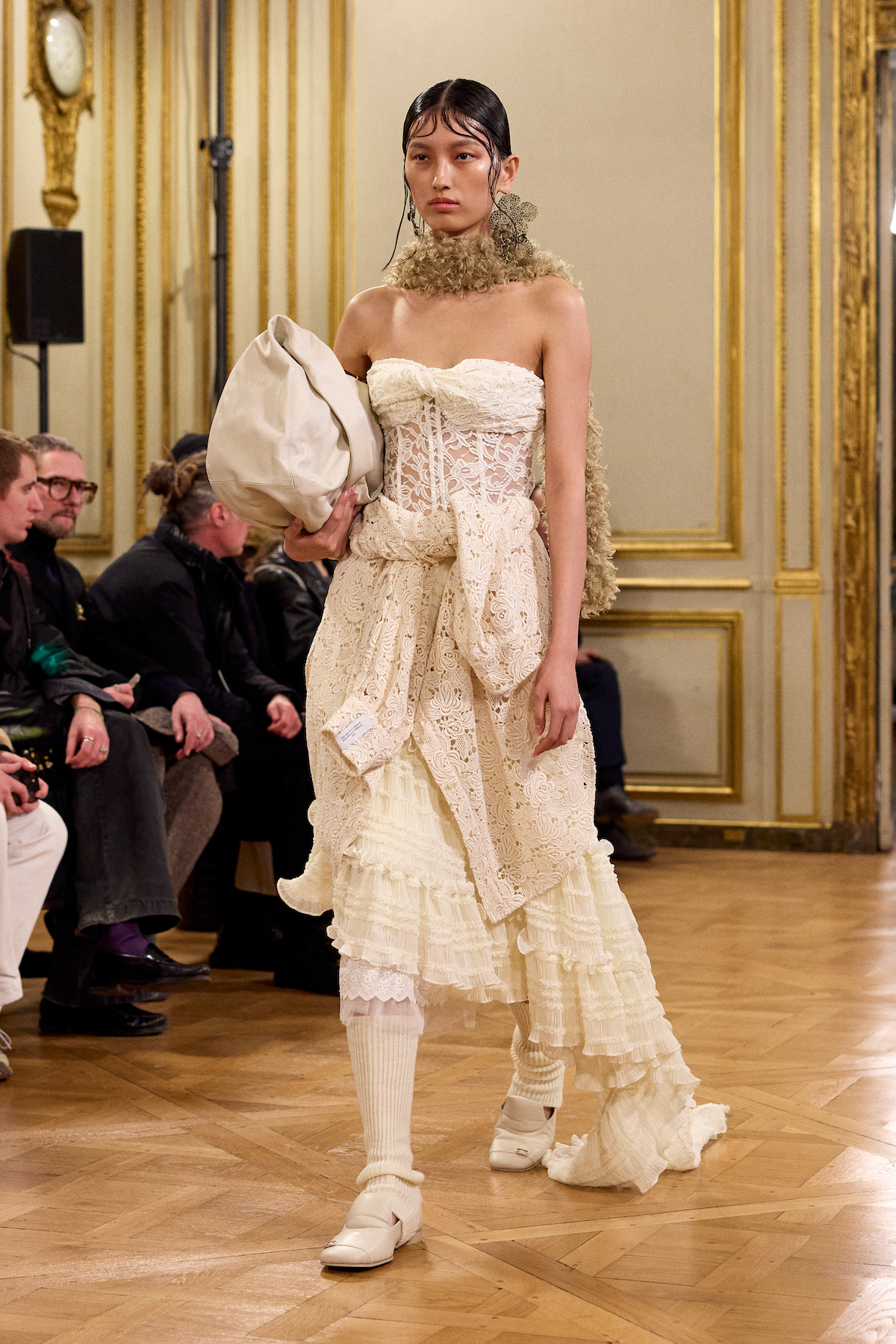
Rokh A/W 2024
Presented in the opulent surroundings of Hôtel Mona Bismarck on the River Seine, Rok Hwang’s latest collection saw the designer traverse eras in what was perhaps his most ambitious collection yet. Hwang – who was born in South Korea and grew up in Austin, Texas – said that this season he was thinking about two artistic eras, the high Renaissance and Romanticism. The former, he said, epitomised ‘classical ideals of human form, focusing on perfection and harmony’, while the latter ‘emphasised individualism, and emotion, exploring raw human experiences and irrational aspects of existence’. Here, these ideas clashed in Hwang’s typically mashed-up garments: a deconstructed trench coat became a dress, out of which a ruffled petticoat emerged, while a denim skirt was edged with dramatic twists of velvet, recalling classical drapery. Elsewhere, an exploration of tapestry came in painterly Renaissance prints across sheer tops and dresses, while another look saw a model entirely concealed in jacquard fabric – as if they had torn a tapestry off the wall and placed it over their head. Meanwhile, flourishes of fax fur – here in long, trailing scarf-like adornments – added to the collection’s mood of collage.
Sacai
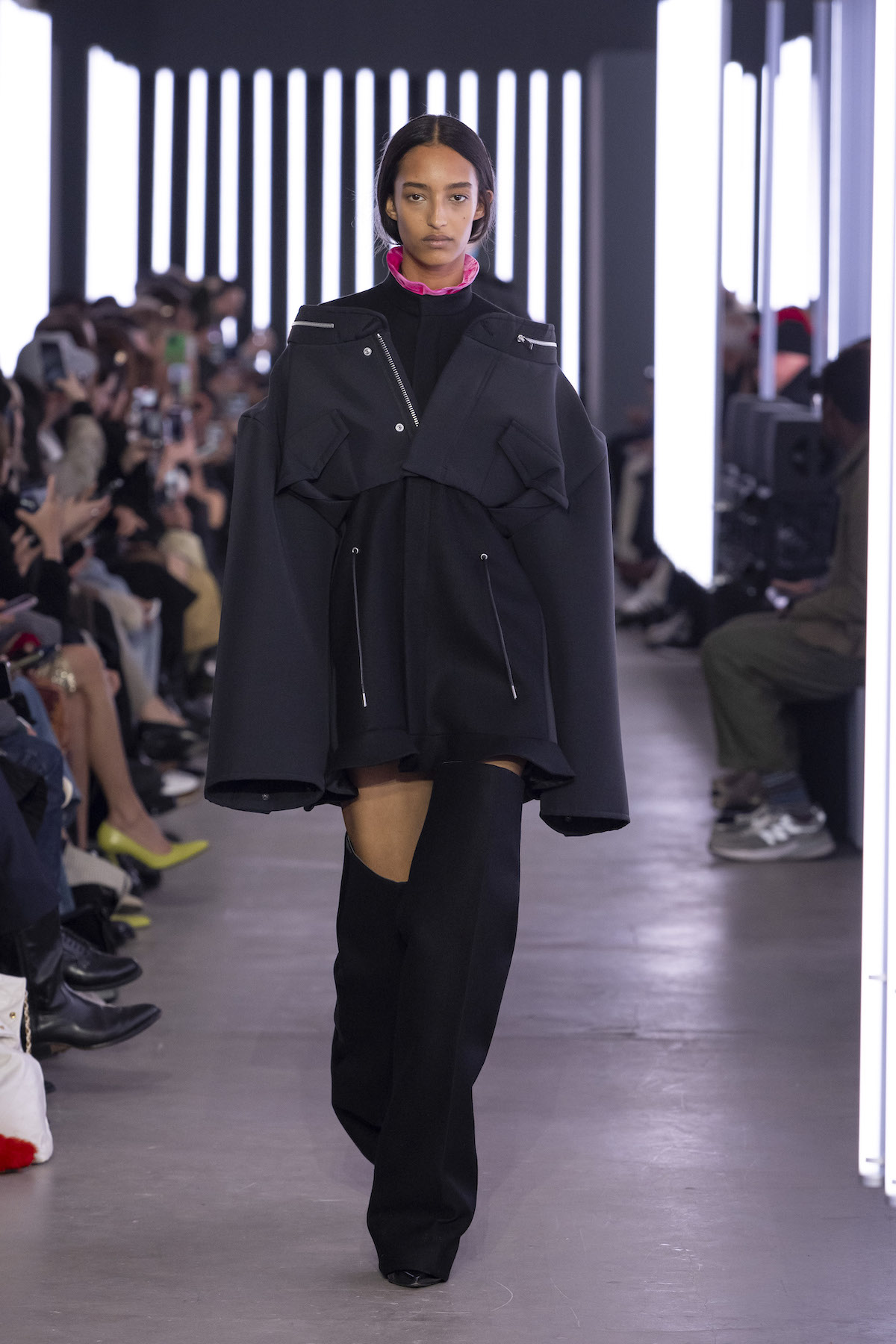
Sacai A/W 2024
Chitose Abe said that this season she was thinking about the ‘emotional protection’ that clothing can afford its wearer, inspired by a quote by the late street style and fashion photographer Bill Cunningham: ‘fashion is armour to survive the reality of everyday life’. As ever, hybridisation was at the heart of the collection (Abe said the signature technique was here ‘spliced to its ultimate expression’), with a series of garments that were inspired by the concept of ‘one-piece’ dressing – the idea that a jacket or a coat could become a dress, a mood evidenced in the collection’s opening looks. There, outerwear was cut to an abbreviated A-line silhouette which recalled a mini dress and was worn with boots; later in the collection, the shape was used across shirting, tailoring and knitwear. Elsewhere, there was a strong use of texture and adornment, from fuzzy webbed and pom-pom knits to dots of pearls and brightly coloured flourishes of shearling.
Valentino
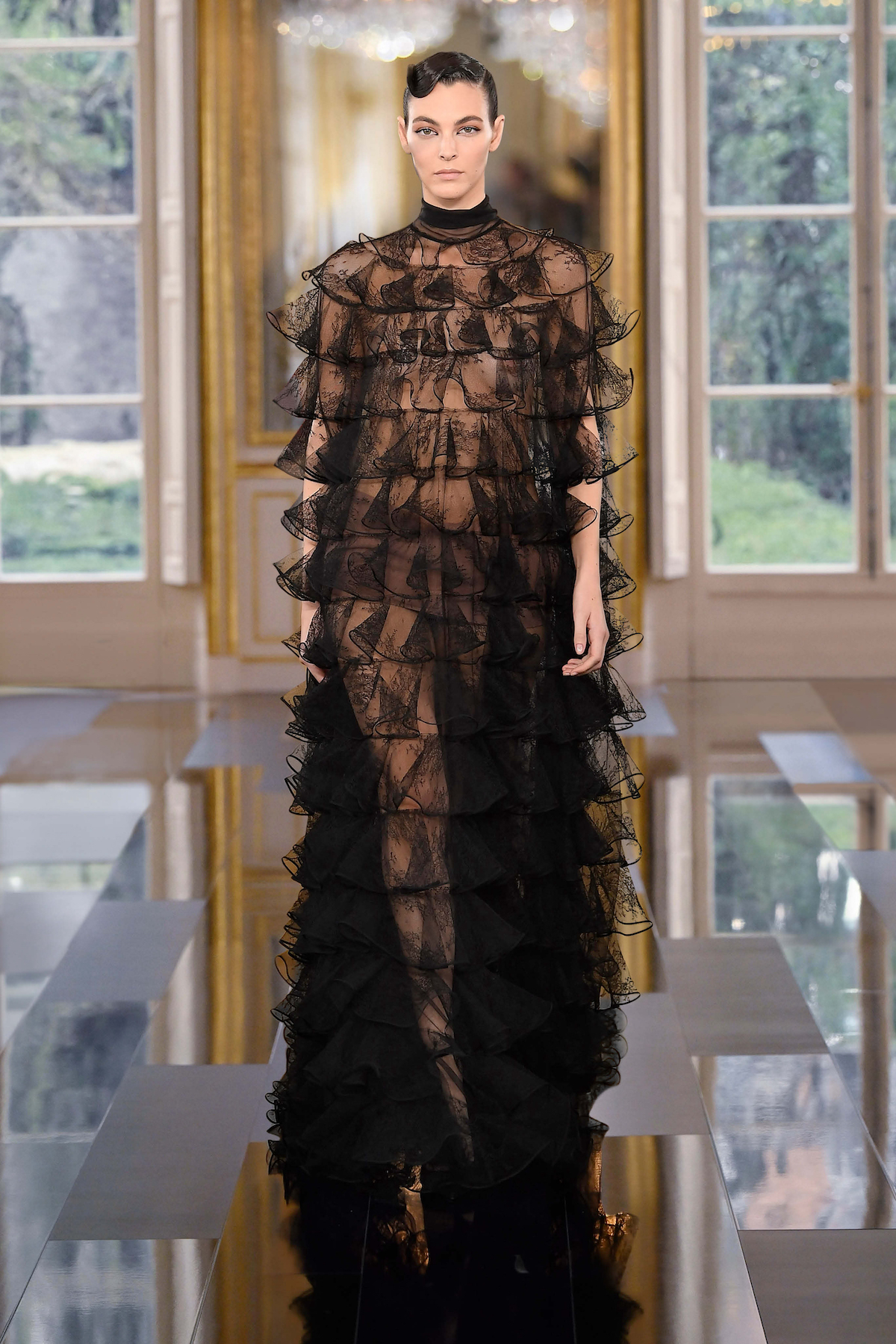
Valentino A/W 2024
Pierpaolo Piccioli’s tenure at Valentino has been defined by a virtuosic use of colour, making this season, which was titled ‘Le Noir’ and rendered entirely in black, a departure. ‘Black is the uniform of democracy,’ read the Charles Baudelaire quote on the collection notes, while Piccioli also noted inspiration from artists including Mark Rothko (a talking point of the season, as Rothko’s works are currently on show at Fondation Louis Vuitton) and Constantin Brâncusi. Some looks leaned classic – a perfectly cut sleeveless top and tailored trousers, worn by Mona Tougaard with a gently creased leather opera glove, for example – while others recalled the house’s haute couture line in their intricacy, like the millefeuilles of sheer lace ruffles (against the skin, black became a different hue) or the delicate hooded gowns which recalled a figure in mourning. ‘Black can challenge and explode stereotypes,’ said Piccioli via the collection notes. ’As Baudelaire intimates, black holds within itself its own democracy. Day and evening blur together, precious silhouettes and embellishments are given new reality, relatability… an entire spectrum of shades, infinitely nuanced, within one.’
Akris
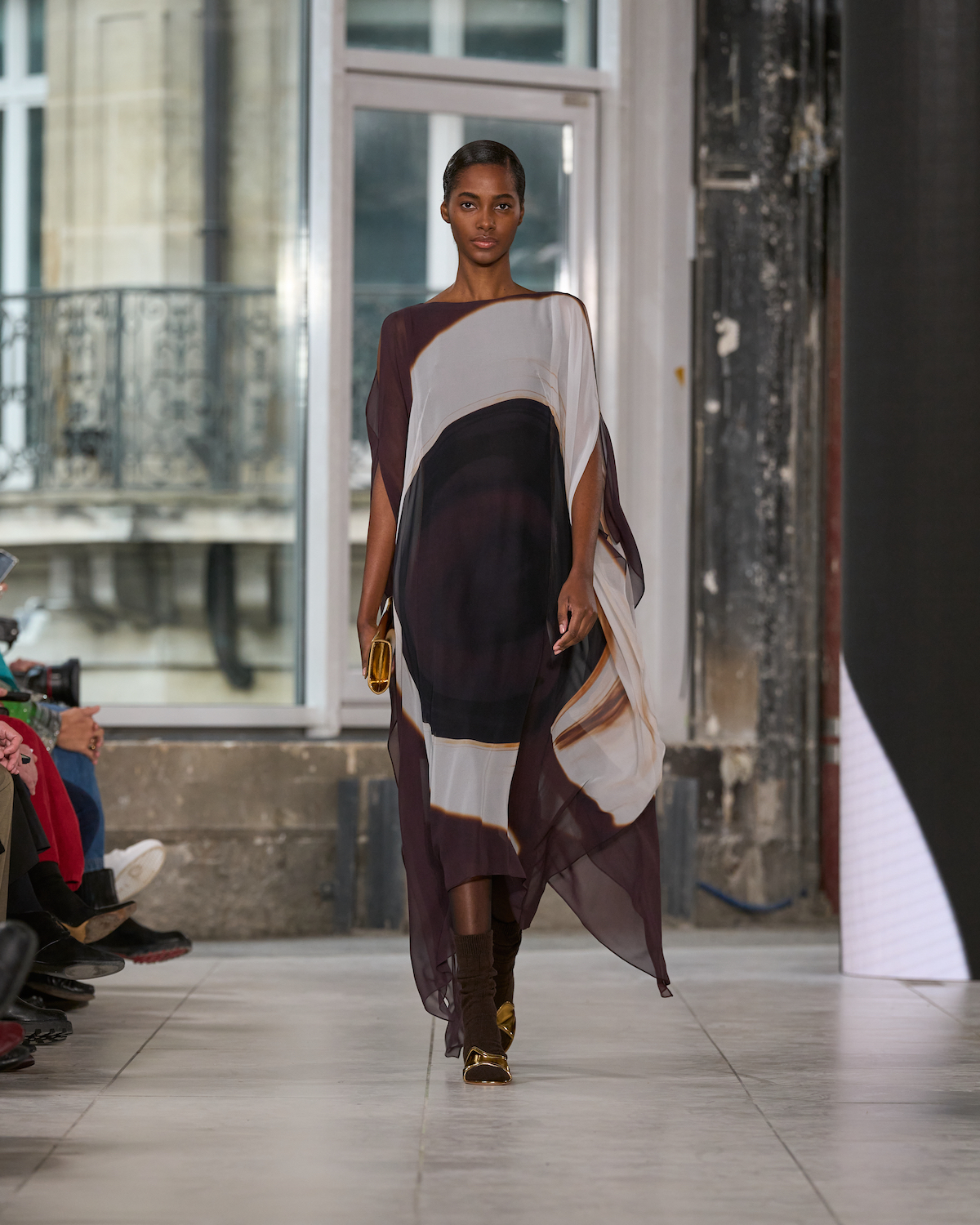
Akris A/W 2024
A strong outing from Albert Kriemler at Akris saw the designer think about the idea of ‘duality’ – ‘shadow and light, simple and layered, protection versus projection’. The photograms of Switzerland-based artist Katalin Deér became symbolic of the collection’s interplay between light and dark, and appeared as prints on the diaphanous, colour-soaked dresses which closed the show. ‘I discovered the photograms of Katalin Deér at Art Basel,’ said Kriemler. ‘Hidden beauties breaking into the light. A photogram is an analogue work of art, and to use it for digital photo prints on fabrics, a technique that we pioneered in the early 2000s, resonated with me.’ Elsewhere, a typically considered wardrobe for the ‘contradictions and routines’ of contemporary life, seeing Kriemler contrast tough outerwear and sharply defined tailoring with softer layers of organza, silk and sequins.
Balenciaga

Balenciaga A/W 2024
The invitation for Balenciaga’s A/W 2024 show was an eBay parcel, in which a second-hand object – from porcelain bears to candle sticks and band T-shirts – had been hand-selected for each of the 800 or so guests. It is not the first time eBay has been brought up by a designer this season (in London, Molly Goddard said her show was inspired by her eBay watch list); here, Demna noted the particular thrill he gets when an eBay parcel arrives on his doorstep. Indeed, the collection had a mood of eclecticism one might associate with an endless scroll on the auction site: a series of DIY dresses, made from a collage of other garments, were what he called ‘one-minute designs’ (backstage, he referenced the challenges on TV show Project Runway). Elsewhere, the Georgian designer doubled down on his distinct aesthetic: dishevelled (faux) fur coats, face-shielding sunglasses, blown-up corporate tailoring and references to subculture, like one look adorned with chains and studs, repeated throughout. ‘This show had to represent me and my style,’ he said. ‘This is the aesthetic I’ve been hammering for ten years, and I’m going to continue doing that as long as I do fashion.’
Alexander McQueen
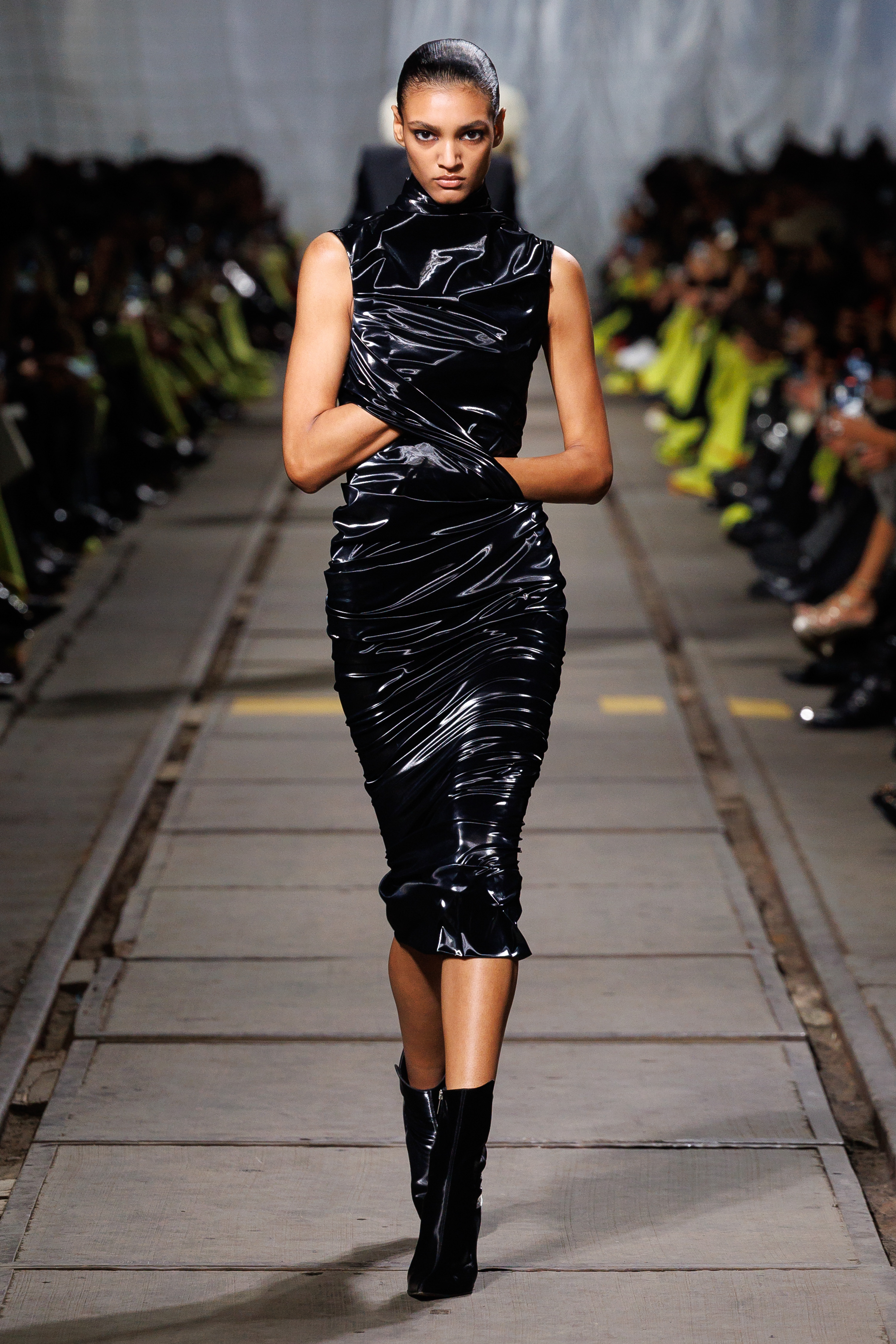
A much-anticipated debut collection from Irish designer Seán McGirr at Alexander McQueen saw attendees travel to a disused tram shed in Paris’ 13th arrondissement on Saturday evening. The location recalled those favoured by the late Lee McQueen; in particular, The Birds, his S/S 1995 show held in a warehouse in a then un-gentrified King’s Cross. That collection, which was inspired by ornithology, as well as the creeping unease of the Alfred Hitchcock movie of the same name, was also the starting point of McGirr’s own journey at the house, the designer noting that it was the first show he looked back at when he began his tenure.
Indeed, McGirr – who was previously head of menswear of JW Anderson and a graduate of McQueen’s alma mater Central Saint Martins – attempted to channel the fierce energy of the designer’s seminal 1990s and early-2000s collections into this opening gambit (he also noted A/W 2001’s Voss and McQueen’s final collection, Plato’s Atlantis, as further touch points). There were T-shirts which appeared like broken glass (a reference, said McGirr, to his broken iPhone screen), moulded dresses crafted from the same material as car chassis that models were bolted into, and gowns which trapped the arms into their construction, while sharp pitched-shoulder tailoring was cinched at the waist with twisting leather ties. Other pieces, said the designer, had a DIY energy, and came from a desire to return to the feeling of being a student, slicing away at garments and fabrics in an attempt to create new forms. Enormous knit sweaters, meanwhile, were a nod to the Aran sweaters of his home country. If it felt occasionally chaotic, that might have been the point.
‘I feel like Lee McQueen's message that he put out into the world is more relevant than ever… this idea of anti-politeness,’ he said backstage. ‘When I see the girls in the shows in the 90s, he was doing the opposite of what was happening in mainstream fashion in a way. The models looked like people on the fringes, the outsiders. That's something I'm really interested in.’
Afterwards, though, the question still lingered: who is McGirr’s Alexander McQueen man or woman? Amid the collection’s shifting silhouettes and moods, it wasn’t always clear. But with less than six months at the house (his tenure was announced in October), he has time to hone his vision, and is certainly not lacking in energy or resolve. One wonders whether the blast of Enya’s Orinoco Flow at the end of the show might have been a clue as to where he looks next. Just as McQueen mined the costumes and lore of British history for inspiration, McGirr’s native Ireland might prove just as fertile creative ground. We’re intrigued to see his next move.
Hermès
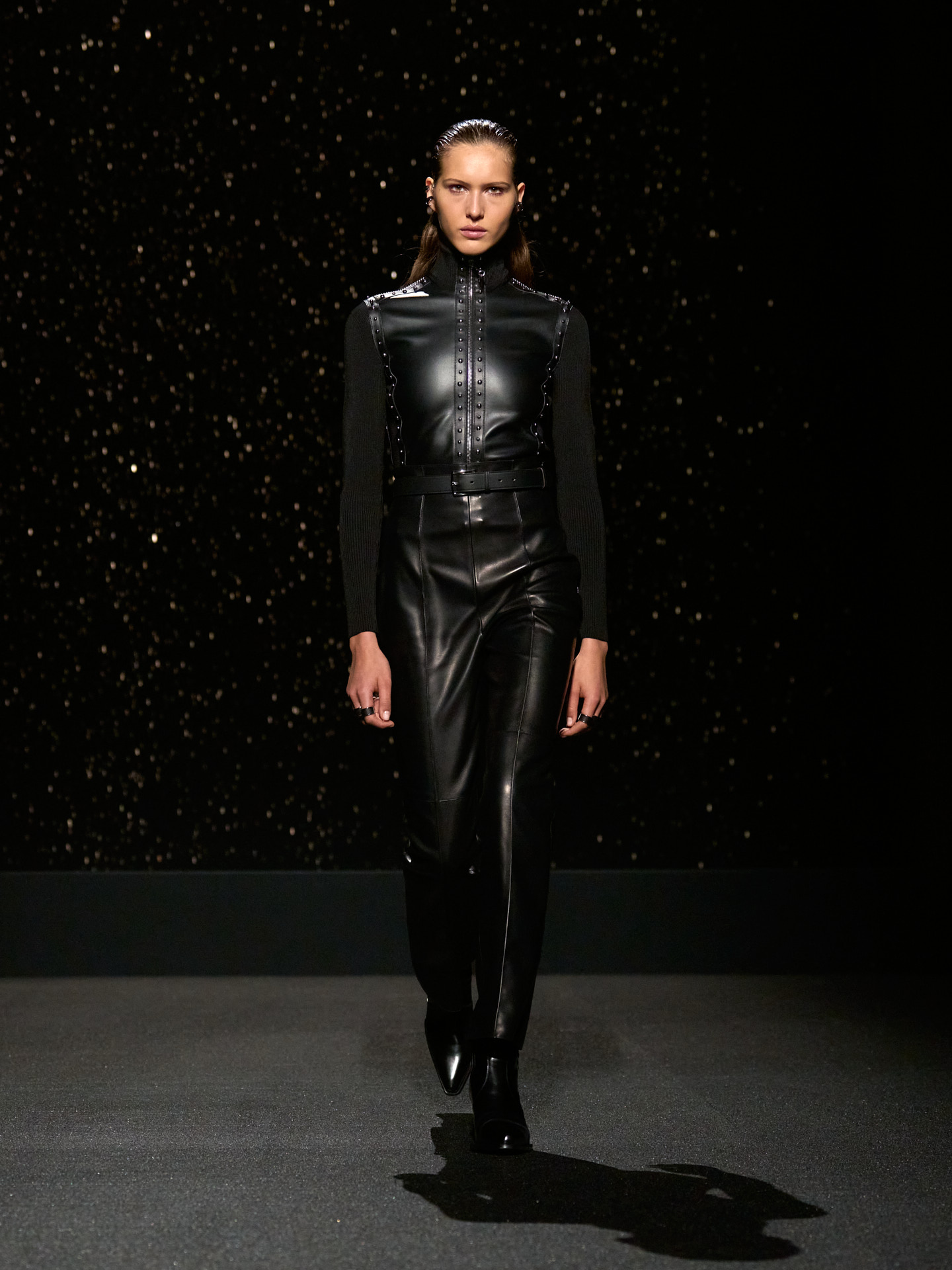
Hermès A/W 2024
It was raining both outside and inside of Hermès – the former a symptom of Paris in early March, the latter an impressive theatrical trick which saw gallons of water pour from the ceiling and onto the runway of the specially built space (for those worried about the clothing, models walked on either side of the downpour). Creative director Nadège Vanhee titled this season’s collection ‘The Rider’, encapsulating what felt like a tougher outlook from the designer, one which she said was inspired by imagining a woman on the move. As such, studs adorned edged poncho-like overcoats and sculpted knit dresses, while the raised collar of a leather overcoat seemed to recall the construction of a motorcycle jacket (albeit here stripped back in the designer’s cooly minimalist style). Other garments nodded to trips in the country, whether zip-up leather riding boots, quilted jackets or enveloping roll-neck sweaters. ‘Astride a horse or a motorcycle… boldly she rides on,’ said Hermès.
Andreas Kronthaler for Vivienne Westwood
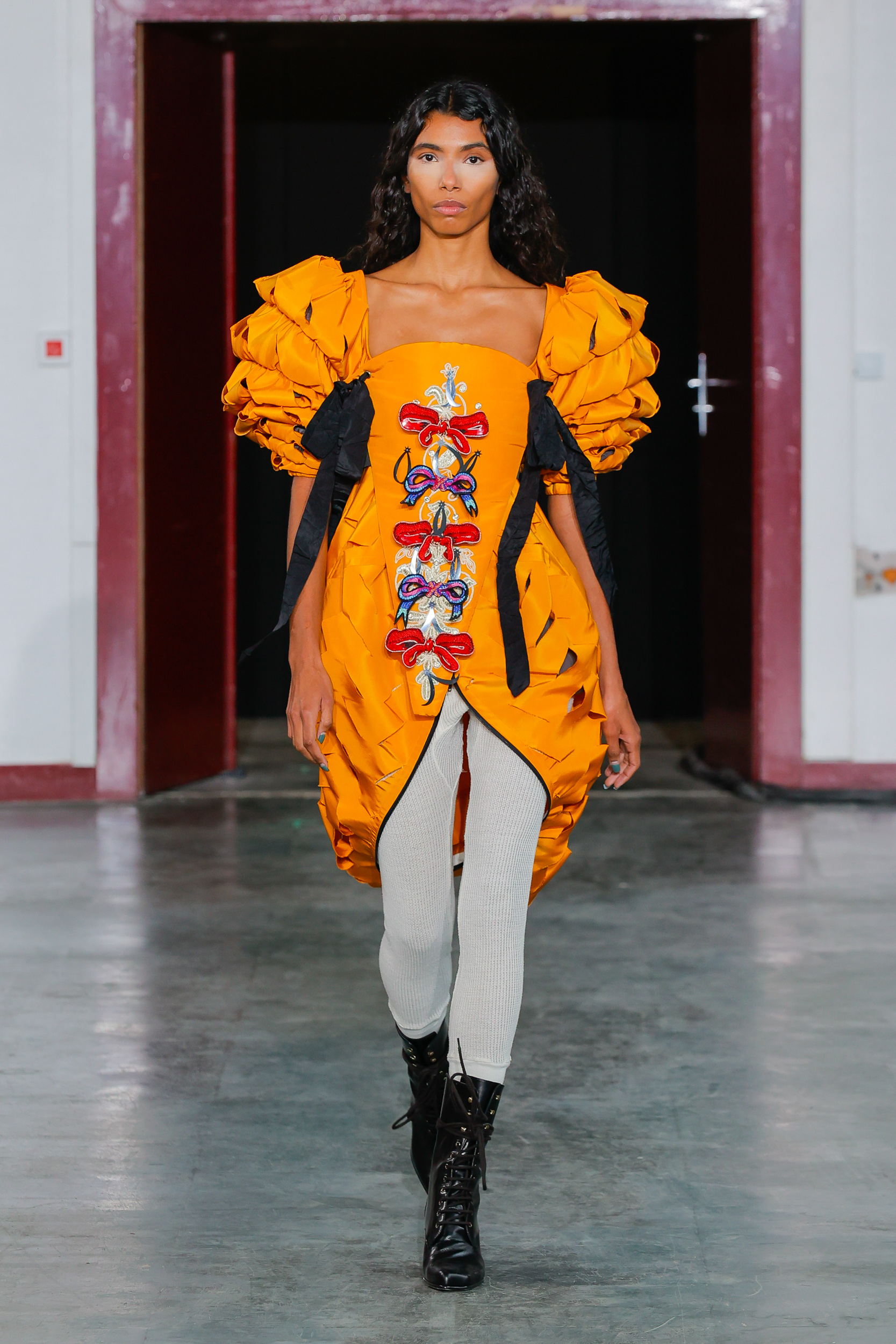
Andreas Kronthaler for Vivienne Westwood A/W 2024
A surreal performance from Simon Mayer’s Sons of Sissy – which riff on Austrian folk traditions in humorous, offbeat style – provided both the centrepiece and soundtrack for Andreas Kronthaler’s latest collection (think: yodelling, axe-wielding, and bottom-slapping dances). They were part of a typically eclectic outing from the Austrian designer, who said backstage that this collection began with a Giovanni Batista Moroni exhibition in Milan, the designer fascinated by the ‘elegance and austerity’ of his portraits (in particular, the doublet-clad figure in late 16th-century painting ‘The Tailor’). ‘We always talk about history and historical figures and I went back to that this season, even as I wanted to move ahead,’ he noted after the show, setting the scene for a collection of codpieces, ruffles and bows, albeit translated in Kronthaler’s imaginative style. Elsewhere, hallmarks of Westwood’s work continued to run throughout – from the towering platform boots and ballooning silhouettes to swathes of tartan, here sliced away into a mini kilt and worn on the runway by a staff-wielding Sam Smith.
Noir Kei Ninomiya
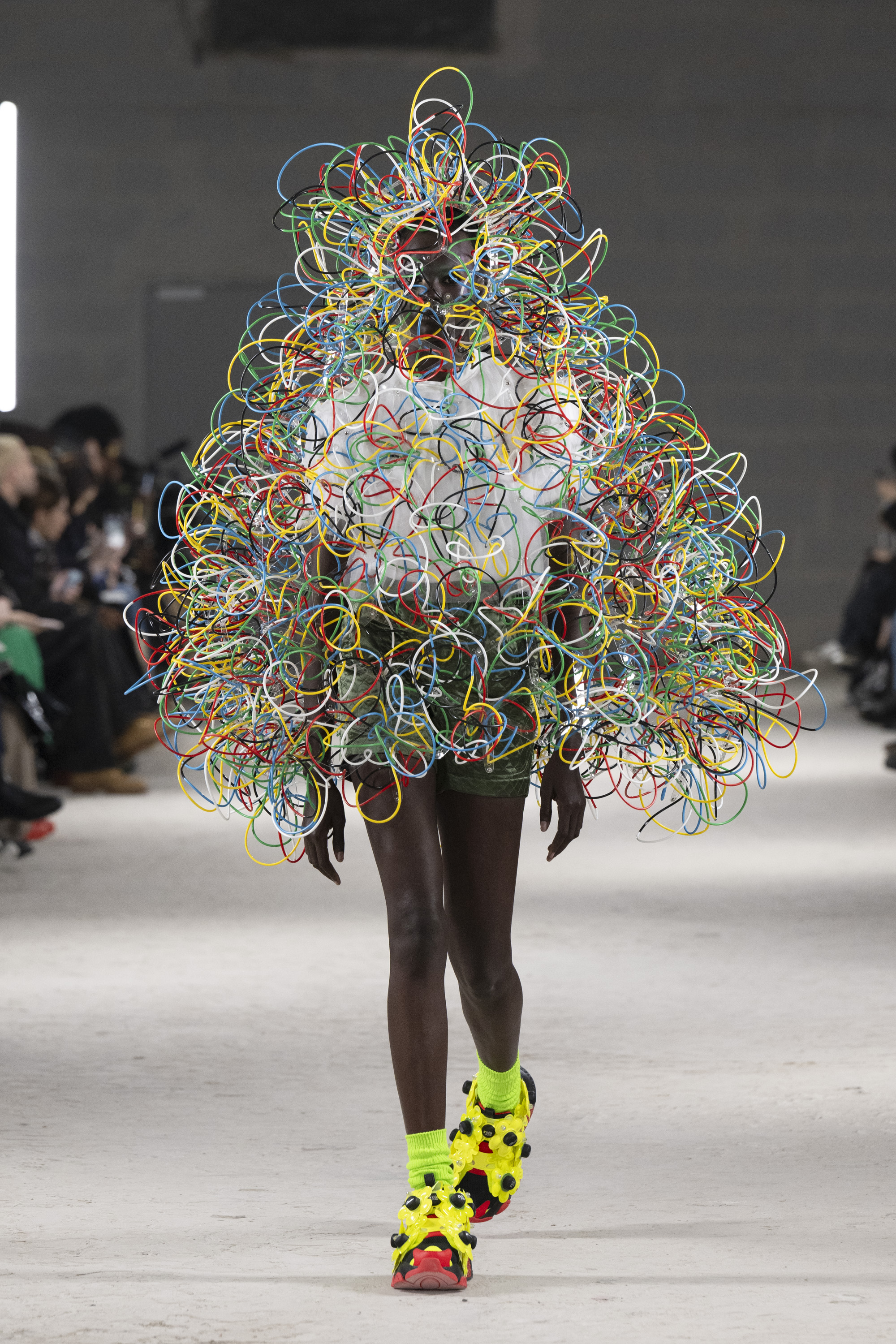
Noir Kei Ninomiya A/W 2024
There was a feeling of levity and play to Kei Ninomiya’s A/W 2024 collection, which the Japanese designer titled ‘Iridescent’. Set to a cranking soundtrack with a fairground-style announcer calling out the various looks by number, out bounced his models in typically intriguing creations which this season were defined by a liberated use of colour. Across the designer’s sculptural silhouettes – largely A-line in construction – were rainbows of crystalline feathers, pinwheel flowers, and clear geometric motifs which recalled 1970s crochet (though here were solid, like stained-glass windows). As ever, it was a guessing game as to what garments were actually made from and how, though in typical alchemist’s style, the designer refused to reveal his secrets. Instead, like the other designers in the Comme des Garçons group, he simply offered a succinct statement on the season in way of explanation. ‘I chose to focus on creating something new using different colours and textures, and play with the reflection of light,’ he said.
Junya Watanabe
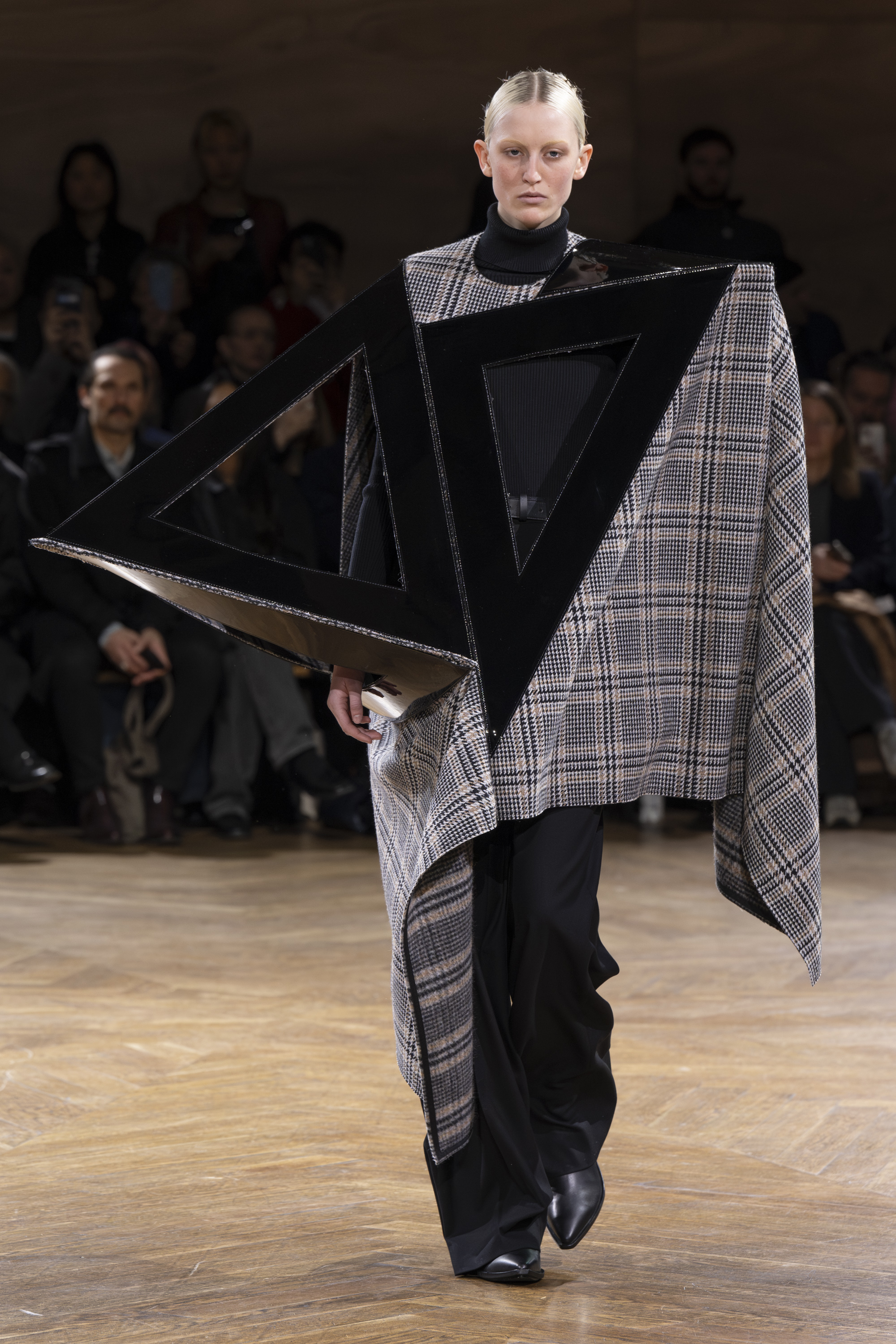
Junya Watanable A/W 2024
‘I want to express the beauty of the contrast between clothes and sculptures,’ said Junya Watanabe of his latest collection, presented on a drizzly Saturday morning at Elysée Montmartre. As such, geometric triangular cutouts and protrusions interrupted the line of quotidian garments (like the overcoats which opened the show), while other looks saw sculptural adornments sit atop more classic high-neck sweaters, wool trousers and skirts. Meanwhile, experiments in leather ran throughout – some thick and protective, looping around the body in cut-out folds, others seeing the material sliced into tasseled strands or adorned with mock-croc motifs. Shape came too in twisting puffer jackets, while a series of floral dresses, overlaid with sculptural deconstructed coats (an echo of the geometric forms at the start of the show) captured the juxtaposition at the heart of the collection. It was completed with black chain-adorned mules made in collaboration with sneaker brand Hoka – a no doubt holy grail for Junya fans when they arrive in stores later this year.
Issey Miyake
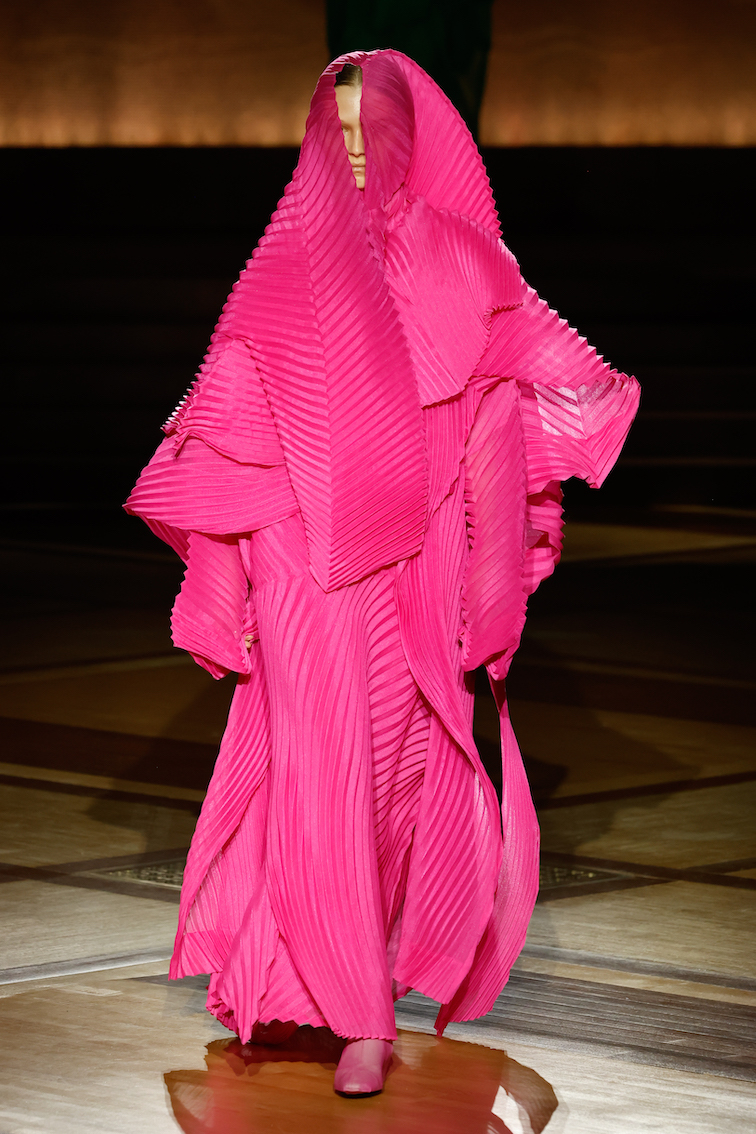
Issey Miyake A/W 2024
There was something instinctual about Issey Miyake’s latest collection, which was titled ‘What Has Always Been’. ‘The act of clothing the human body,’ explained designer Satoshi Kondo of the season’s inspirations in a letter left on attendee’s seats. ‘It is as spontaneous as it is deliberate, on that the hand responds before the mind does.’ Indeed, the collection’s wrapped, draped and intricately layered silhouettes recalled ancient dress codes – the feeling of using fabric to protect and envelop the body against the elements – while complex pleated garments, which concealed the wearer almost entirely, had a ceremonial flourish. Meanwhile, moments of lightness and play (hallmarks of Issey Miyake’s design philosophy) emerged in the as-ever expert use of colour and painterly prints which ran throughout. ‘We explore, feel, and grasp what has always been, nothing more and nothing less,’ concluded Kondo.
Loewe

Loewe A/W 2024
Jonathan Anderson used his womenswear collection for Loewe as an opportunity to stage an exhibition of the works of Albert York, a reclusive American painter who gathered a small but devoted following in his lifetime (former first lady Jacqueline Kennedy Onassis was an avid collector). In total, 18 of the works – which comprise pastoral landscapes and studies of flowers and animals – were on show here, making it the largest exhibit of York’s work outside of the United States. Dotting the green-hued corridors which partitioned the Chateau de Vincennes showspace, Anderson called the paintings ‘small but intense’.
The choice, Anderson elaborated backstage, was about the idea of context. He was thinking about luxury: the near ‘grotesqueness’ of York’s bucolic paintings (which the artist said were an attempt to capture the ‘paradise’ of the world and its natural landscapes) ending up sitting on the walls of an Upper East Side apartment. He likened it to the ceramics decorated with flowers and botanicals from the 18th century, which would then be used on the heaving tables of the land-owning elite. In the collection, hazy floral prints were drawn from china made by the famed Chelsea porcelain factory in the era, while a series of extraordinary ‘caviar’ beaded garments and accessories, evoking eagles, dogs and asparagus, were another attempt to shift the familiar out of context. ‘I like the idea of craft becoming something else,’ he said. ‘How you can look at historical craft, things that aren’t to do with clothing, and apply it to something else.’
This idea of subversion – ‘the tropes of class and wealth turned on their head’ – ran through the collection itself, which riffed on upper-class dress codes in Anderson’s idiosyncratic style. Etonian dress coats were elongated on their tails so they dragged on the floor (the designer had studied a pile of vintage garments to understand their construction), while cable-knit sweaters and ties were worn with high-waist trousers adorned with enormous, near-futuristic studs. This was aristocratic dressing, albeit in Anderson’s typically twisted style. 'The aristocrat is almost a foreign thing now,’ he elaborated. ‘A caricature.’
Givenchy
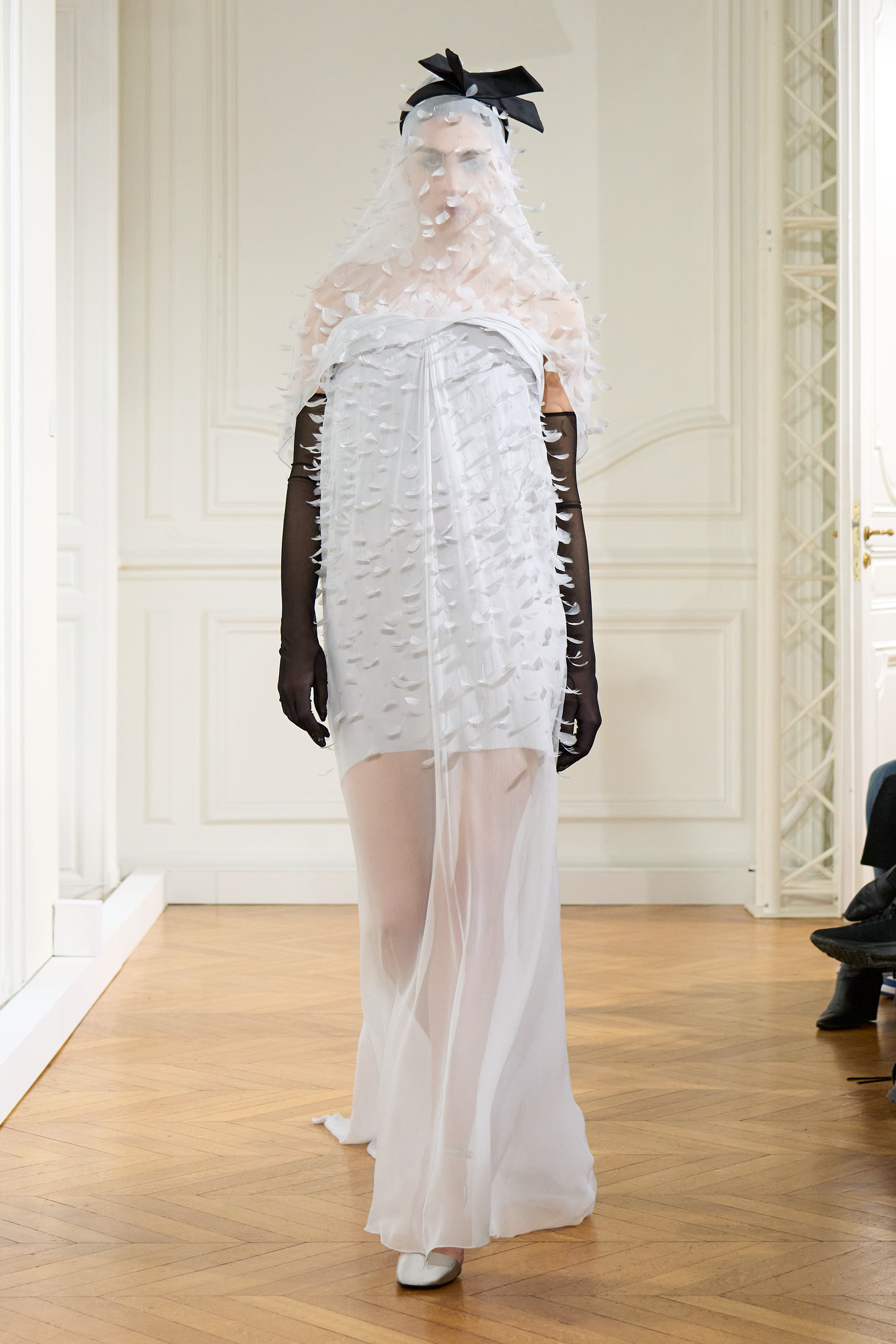
Givenchy A/W 2024
Givenchy took to the house’s historic couture salon on Avenue George V to present its first womenswear collection since the departure of American designer Matthew M Williams in December 2023 (a men’s collection was shown in the same history-steeped space in January). As his successor is yet to be announced – though naturally rumours continue to circulate – it was down to the house’s design team to create the interim collection. To do so, they attempted to conjure a woman of ‘sensuality and suspense’ with an A/W 2024 collection rooted in the archival designs of house founder Hubert de Givenchy. He is best known for his association with a slew of celebrated women (most famously Audrey Hepburn); here, the team channelled this same spirit in evoking a dressed-up wardrobe for potential cinematic muses of today, from draped and sculpted gowns to riffs on the tuxedo. Befitting the setting, the collection was illuminated by moments of embellishment: the extraordinary beading on the opening look more than stood up to the salon’s synonymy with Parisian craft. It closed with a very modern bride: the American model Amelia Gray, who donned a delicately feathered gown with in-built veil, pulled down for her strutting finale walk.
Schiaparelli

Schiaparelli A/W 2024
At Schiaparelli, Daniel Roseberry continues to define his ready-to-wear offering for the haute couture house, now in its third season. It’s raison d'être: to create ‘fully formed, hyper-exclusive collections’, described the American designer in a letter to attendees. ‘A complete wardrobe of everyday staples – but with the volume turned up to Schiaparelli settings.’ It‘s hard to argue that Roseberry isn’t doing just that, taking archetypal ready-to-wear garments – blazers and slacks, double-breasted overcoats, denim shirts, jeans – and instilling them with moments of surreal adornment inspired by house founder Elsa Schiaparelli, whether buttons or buckles shaped like eyes or shells, or neckties which appeared like plaits of hair. ‘It’s made for every day, not just the rare, precious moments of life when only couture will do,’ Roseberry elaborated of the ready-to-wear outing, which had a distinctly 1980s mood. ‘It’s for every occasion and everywhere – just make sure you can get used to being asked “Excuse me... where did you get that piece?”’
Rabanne
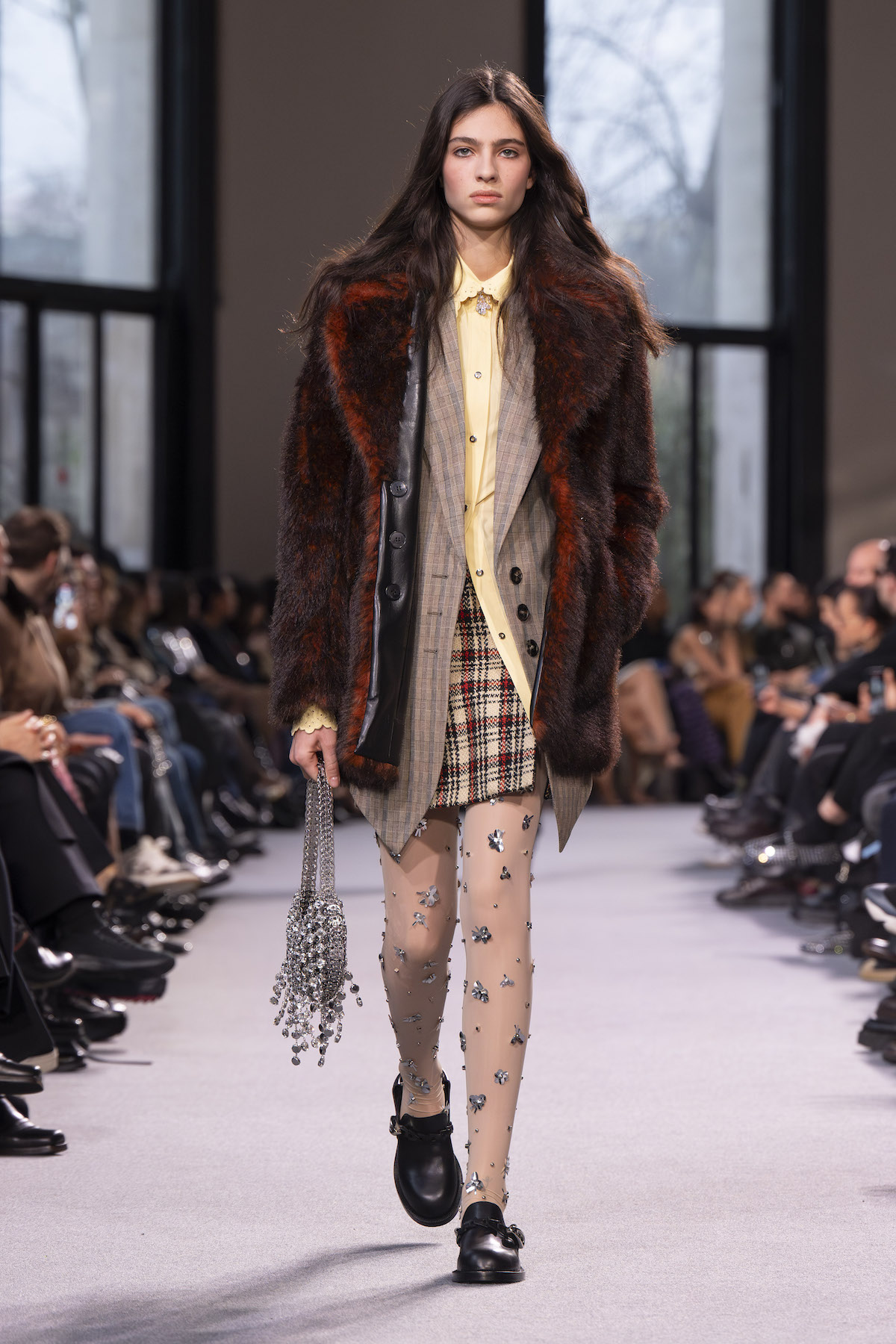
Rabanne A/W 2024
A brilliant collection from Julien Dossena at Rabanne revelled in the clashing and the unmatched. ‘Grunge, art school, borrowed clothes, vintage one-offs, menswear, 1970s graphic design,’ were noted by the French designer as some of the season’s expansive reference points, lending the collection a freewheeling energy. Looks were layered with abandon: fuzzy cheetah print sweaters, houndstooth overcoats, plaid blazers, polka-dotted skirts, checkered knits and chainmail cami tops all added to the collection’s glorious pile-up of elements, born from ‘an indescribable longing for everyday originality’. Dossena called it a ‘matrix of possibilities’ imbued with the distinct pleasure of finding a cherished piece in a vintage store or on an eBay trawl – here epitomised by the pairs of tights adorned with delicate metal petals, studs and chainmail disks, like hidden treasures waiting to be discovered.
Chloé

Chloé A/W 2024
The Chloé girl is back. So was the consensus after Chemena Kamali’s debut collection for the Parisian house, presented on Thursday morning (29 February) in a former telephone exchange on Rue du Faubourg Poissonnière. ‘I want to bring back the feeling I had when I first stepped through the doors here 20 years ago and fell in love with the Chloé woman’s spirit,’ said the German designer, who began her design career at the house under Phoebe Philo (since, she has worked as a designer for numerous other brands; most recently, she was design director at Saint Laurent). ‘I want to feel her presence again; her beat, her natural beauty, her sense of freedom and undone-ness. The glow, the radiance and the energy of that girl. She is real. She is herself.’
It made for a collection that largely drew on fellow German designer Karl Lagerfeld’s two-decade-long tenure at Chloé, beginning in the early 1960s (he would later return in the 1990s). He would define the breezy, bohemian aesthetic most readily associated with the house, continuing founder Gaby Aghion’s desire to dress her friends who favoured ease over lengthy haute couture fittings in the 1950s. Here, Kamali did so through a sense of fluidity: a series of brilliant riffs on the sheer ruffled dress (some abbreviated at the hem or elongated at the sleeve, others asymmetric) recalled Chloé’s defining silhouette, while recurring caped motifs also nodded to the house’s heyday. A melange of accessories, meanwhile – from handbags with banana hardware to golden snake jewellery and looping Chloé signature belts – continued the collection’s eclectic mood. You could certainly imagine women shopping from its composite parts.
‘This collection is about intuition, freedom and an instinctive female energy,’ said Kamali. ‘It’s about a Chloé with a sense of nostalgia that also mirrors the times we are living in and anticipates how women want to feel today. It’s about what feels right.’
Rick Owens

Rick Owens A/W 2024
Following the designer’s menswear show in January, Rick Owens once again invited showgoers inside his beloved ‘concrete palace’, the converted former French Socialist Party headquarters on Paris’ Place du Palais Bourbon that the designer calls home with his wife Michèle Lamy. On Thursday morning, guests took their places amid the sparse, concrete space, which is populated by the designer’s monolithic furnishings and artworks (in a previous Wallpaper* interview, At Home with Rick Owens, he described it as ‘insulated, isolated, removed, and remote’). The choice of setting, he said, emerged from a desire for human closeness, ‘an intimate move in observance of the barbaric times through which we are living’. This mood of intimacy was reflected in the collection itself, which seemed to suggest protection against the elements: knitted alpaca ‘spacesuits’ enveloped the body in softness, while twisting, padded forms looped around the torso in typically sculptural style. Infusions of strange glamour – which Owens said came from a childhood enchantment to opera – came in the extraordinary closing looks, a series of cage-like gowns crafted from tangles of sequins. They suggested, albeit tentatively, hope.
Acne Studios

Acne Studios A/W 2024
A set of enormous rubber armchairs and stools, crafted by Estonian artist Villu Jaanisoo from recycled car tyres, provided the backdrop for Acne Studios’ latest womenswear collection. Their strange, moulded shapes reflected the collection’s full-throttle mood, which the Swedish brand described as an exploration of ‘toughness and human form, leather and denim’. The latter two fabrics have long been at the heart of Acne Studios; here, they were reimagined in sculpted, near-industrial silhouettes, described by the brand as ‘mechanical’ (case in point, a series of moulded leather overcoats and dresses which recalled armoured chest plates). Denim, meanwhile, was typically twisted: skewiff shirts and jackets were coated to give an oily effect, while a pair of jeans appeared smeared with rust. ‘I’ve always been drawn to leather and denim. It’s the spirit of Acne Studios,’ said creative director Jonny Johansson. ‘One of our first collections in the late 1990s was quite literally called “leather and denim”; [they are] two things that belong together.’
But there was a surprising softness to the collection, too: elongated jersey dresses and Henley-style T-shirts had the comfort of bedwear, while chunky-knit hooded dresses look set for hunkering down in a Swedish winter (such juxtapositions are a signature of Johansson’s work, which often swerves between the tough and sweet). Meanwhile, moments of elegance – which Acne Studios described as riffs on ‘archetypes of womenswear’ – came in (faux) fur coats and stoles, ladylike handbags and ‘lampshade’ gowns, which Johansson said were a riff on traditional haute couture, jutting out at the hips like panniers. ‘This collection is about the juxtaposition of an elevated femininity and a biker attitude,’ Johansson told Wallpaper*. ‘I wanted to look deeper into the archetypal codes of women’s fashion and confront them with the codes of Acne Studios.’
Courrèges
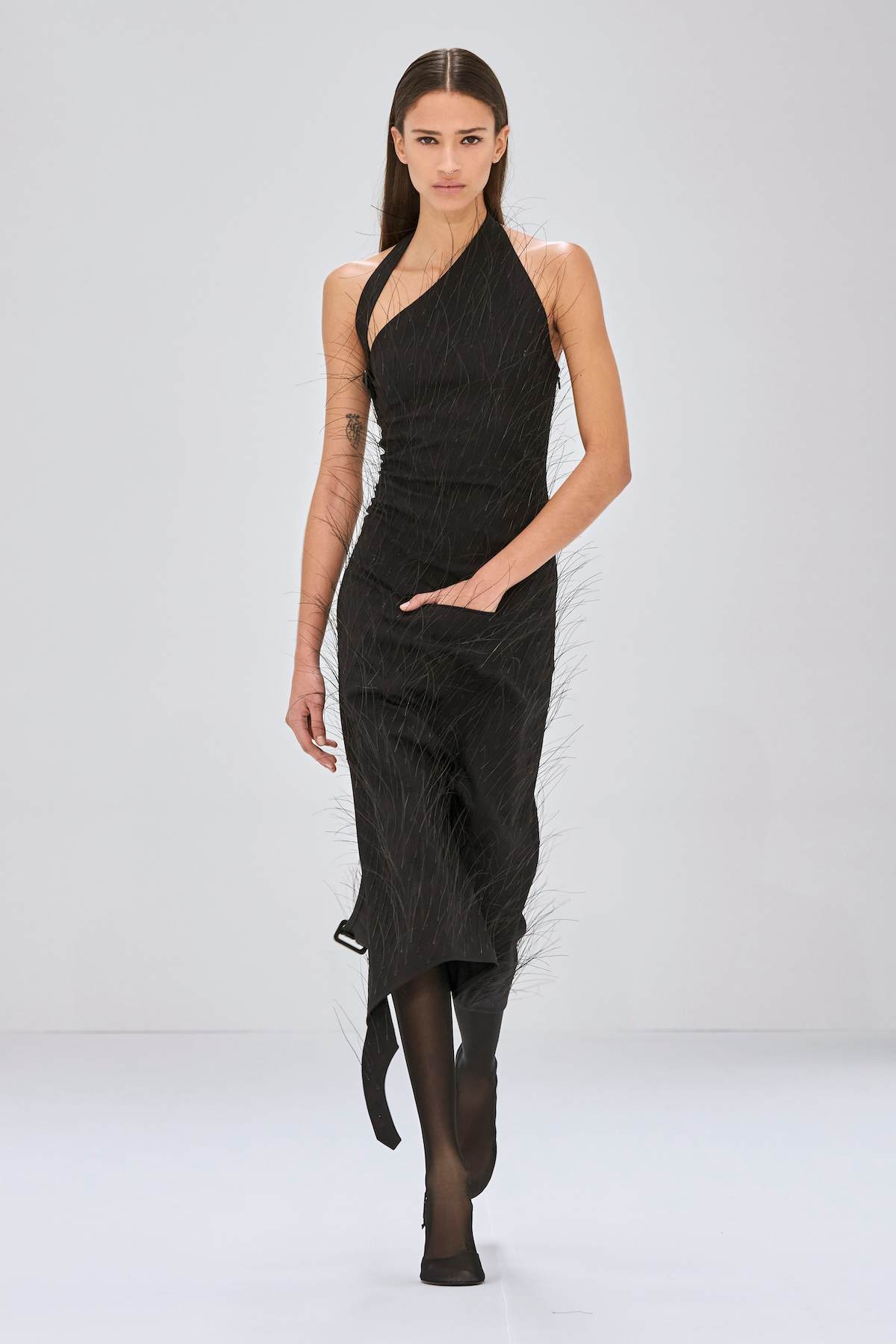
Courrèges A/W 2024
A gently swelling installation, accompanied by the sound of a person’s breath, provided a typically intriguing runway set for Nicolas di Felice’s latest Courrèges collection (last season, the plastered ground cracked beneath the models’ feet). Of the collection itself, Di Felice described it as a musing on ‘symmetry and sensuality’, here looking towards the simplicity of ‘primary shapes’ to continue the designer’s coolly reduced vision for the French house. He likened it to the ‘geometry’ of a square-shaped scarf, which despite the simplicity of its shape can be contorted into a near-limitless amount of forms (‘its plasticity releasing heritage cuts from their expected formality’). So there were clean-lined square-shaped tops and dresses which seemed to hang impossibly on the body without straps or back (in fact, a sheer fabric was holding them in place), while later the silhouettes became sinuous and twisted, cleverly wrapping around the body in ties and twists of fabric. Di Felice said the final looks – some of which fell away to reveal underwear-style details beneath – were designed to recall a woman disrobing, a ‘behind closed doors’ mood reflected in delicate feather appliqué, which marked a rare flourish of adornment from the designer.
Saint Laurent

Saint Laurent A/W 2024
Anthony Vaccarello’s latest collection for Saint Laurent took place in two vast circular rooms, curtained around their exteriors in emerald green damask, recalling the draped windows of the house’s historic haute couture salons at 5 Avenue Marceau. The mood, the designer noted, was one of intimacy and that of a ‘boudoir’, providing an apt setting for a seductive, sensually charged show which riffed on the idea of transparency. ‘Anthony Vaccarello reminds us of what once was at the centre of fashion by rendering it invisible: clothes,’ said the house in collection notes, ‘minimising the distance between garment and skin so the two effectively meld and fabric evaporates like mist.’
As such, the nexus of the A/W 2024 collection was a series of sinuous, gauzy gowns recalling undergarments and hosiery, wrapped around the body in various ways (it followed Vaccarello’s clever tendency to riff on a singular silhouette, or idea). One inspiration, said the designer, was Marilyn Monroe’s notorious ‘naked’ dress, worn by the actress for her last appearance in public in 1962 (memorably, Kim Kardashian donned the dress for the 2022 Met Gala). Indeed, there was a nostalgic glamour to the flourishes of faux fur – like a series of jackets which were not worn but grasped in the hand – or the palette, which Vaccarello said recalled the powdery hues of make-up. And, if full-scale exposure is not your track, a series of perfectly crafted caban-style overcoats or fluid, wide-shouldered tailoring offered an elegant way to cover up – and perhaps a hint of where Vaccarello might be heading next.
Dior
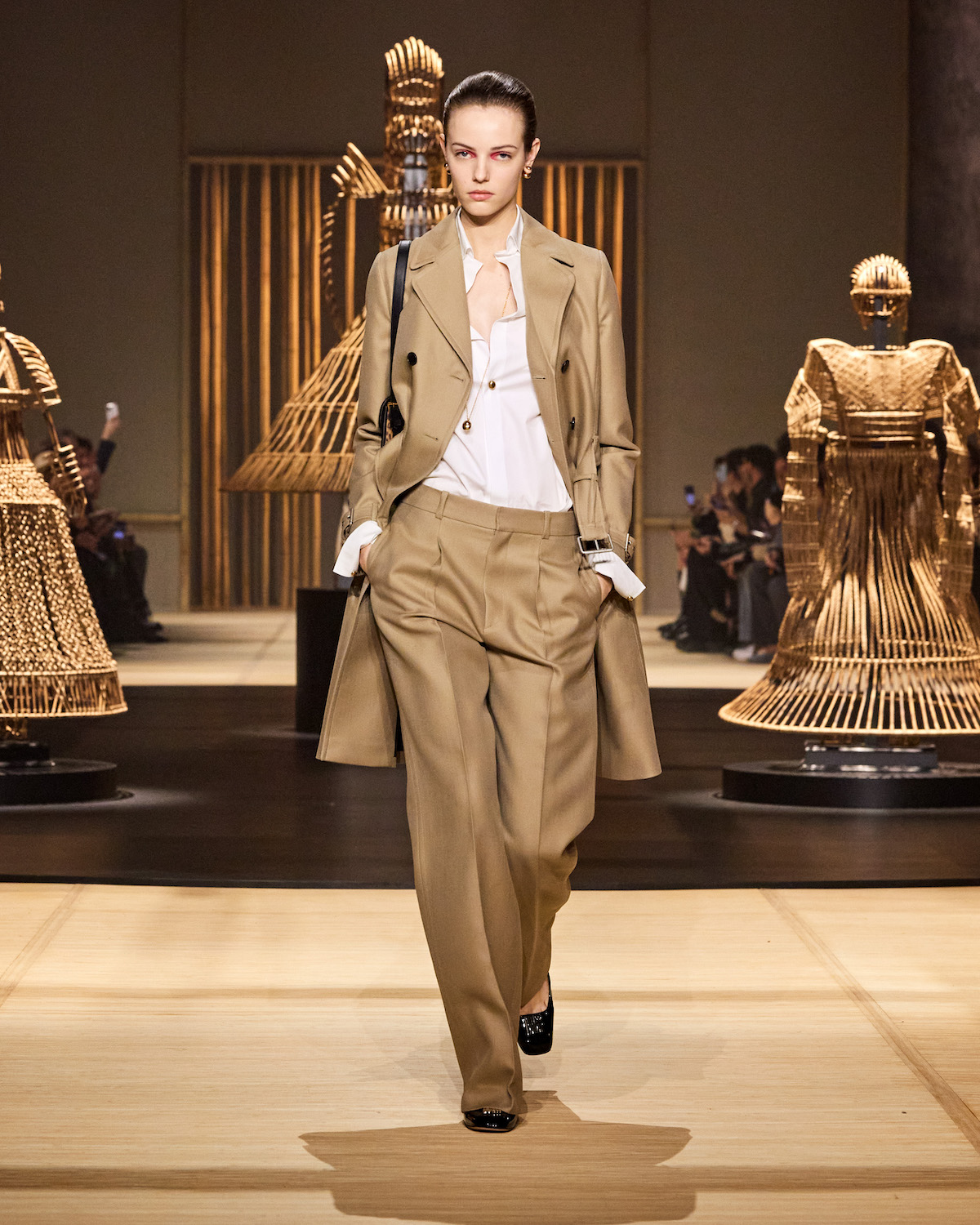
Dior A/W 2024
Maria Grazia Chiuri looked back to the 1960s for her latest collection, an era which the designer said saw ‘fashion leave the atelier to conquer the world’. By this, she meant the advent of ready-to-wear, which allowed shoppers to purchase clothing from Parisian couture houses from the racks of a store, rather than the rarefied haute couture salon (where all clothing was made to measure, and thus the reserve of the uber-rich). Dior’s contribution to this change – led largely by former Dior creative director Yves Saint Laurent’s introduction of its Rive Gauche line in 1966 – was Miss Dior, a womenswear line launched by Marc Bohan in 1967, but entrusted to his assistant Philippe Guibourgé.
In the A/W 2024 collection, Chiuri used this as a jumping-off point to explore the era‘s liberated dress codes – here formulated in easy but elegant everyday silhouettes, like the various riffs on the classic trench coat that ran throughout. Other looks featured abbreviated skirts, nipped tailoring or clean-lined tabard-style tops, while expressions of the Dior atelier emerged in the collection’s closing looks (think: shimmering surface embellishment, metallic tassels, and crystal webbing). The mood, said Chiuri, was designed to evoke the liberation that the Miss Dior line came to represent: a way to fulfil house founder Christian Dior’s desire to dress all women, whatever the occasion. ‘I wanted a woman to be able to leave the boutique dressed in it from head to foot, even carrying a present,’ he is quoted as saying in the collection’s accompanying notes.
In the show itself, models circulated a series of sculptures conceived by Indian artist Shakuntala Kulkarni (it continues Chiuri’s ongoing collaboration with women artists on her evocative show sets). Evoking Kulkarni’s signature works, armature-like figures of women created from cane, they encapsulated a kind of juxtaposition – at once ‘clothing, protecting and transforming’ the body, while ’imprisoning it in a kind of cage’. It was symbiotic with Chiuri‘s interrogation of femininity, which has run throughout her tenure. Here, she noted how the Miss Dior collection became an emblem of a search for ‘a pluralistic, autonomous, and versatile femininity... a moment of creative freedom’ – a mood of liberation that permeated the collection itself.
Stay tuned for more from Paris Fashion Week A/W 2024
Jack Moss is the Fashion & Beauty Features Director at Wallpaper*, having joined the team in 2022 as Fashion Features Editor. Previously the digital features editor at AnOther and digital editor at 10 Magazine, he has also contributed to numerous international publications and featured in ‘Dazed: 32 Years Confused: The Covers’, published by Rizzoli. He is particularly interested in the moments when fashion intersects with other creative disciplines – notably art and design – as well as championing a new generation of international talent and reporting from international fashion weeks. Across his career, he has interviewed the fashion industry’s leading figures, including Rick Owens, Pieter Mulier, Jonathan Anderson, Grace Wales Bonner, Christian Lacroix, Kate Moss and Manolo Blahnik.
-
 How to elevate a rental with minimal interventions? Charu Gandhi has nailed it with her London home
How to elevate a rental with minimal interventions? Charu Gandhi has nailed it with her London homeFocus on key spaces, work with inherited details, and go big on colour and texture, says Gandhi, an interior designer set on beautifying her tired rental
-
 These fashion books, all released in 2025, are the perfect gift for style fans
These fashion books, all released in 2025, are the perfect gift for style fansChosen by the Wallpaper* style editors to inspire, intrigue and delight, these visually enticing tomes for your fashion library span from lush surveys on Loewe and Louis Vuitton to the rebellious style of Rick Owens and Jean Paul Gaultier
-
 Out of office: The Wallpaper* editors’ picks of the week
Out of office: The Wallpaper* editors’ picks of the weekFar from slowing down for the festive season, the Wallpaper* team is in full swing, hopping from events to openings this week. Sometimes work can feel like play – and we also had time for some festive cocktails and cinematic releases
-
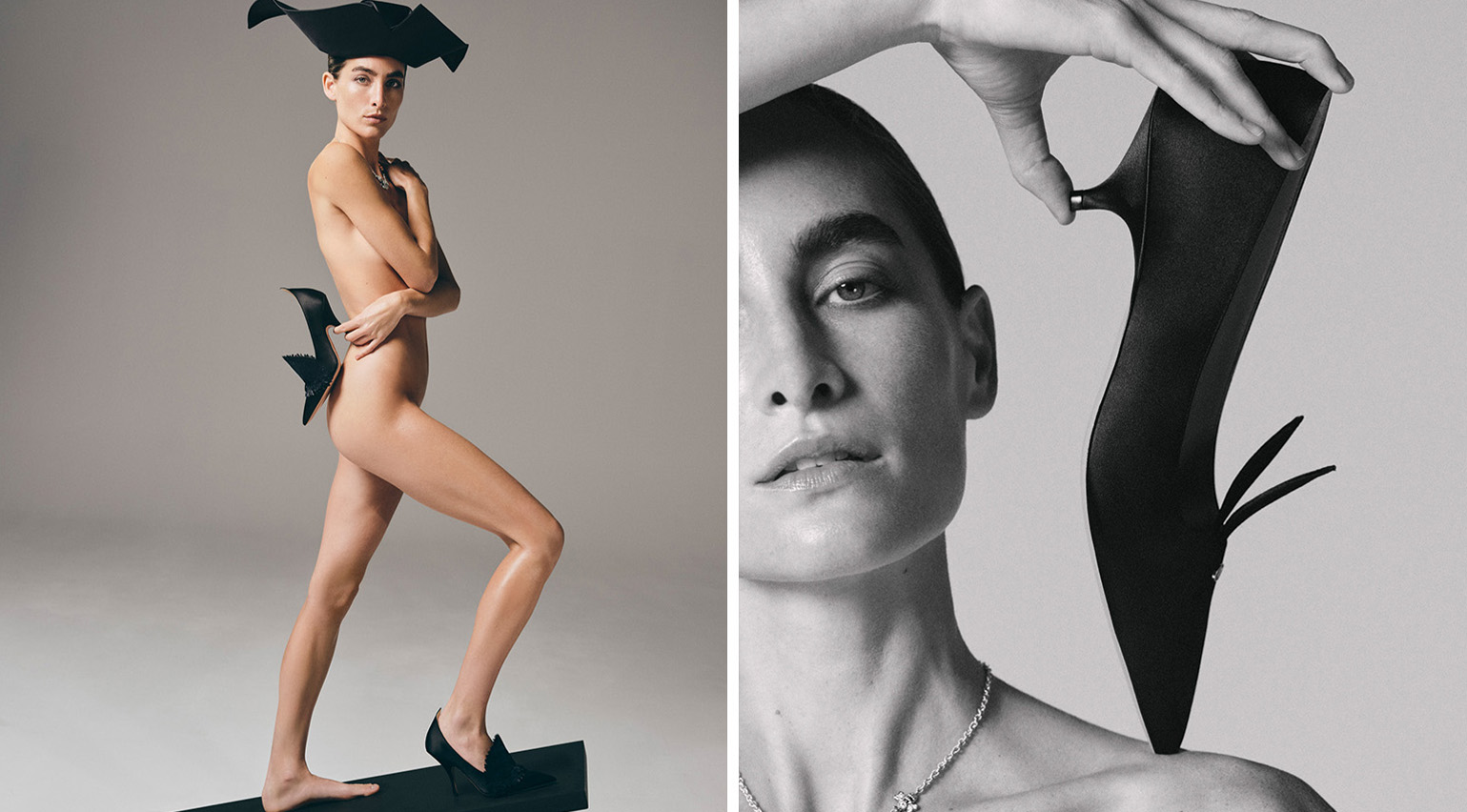 Zooming in on Jonathan Anderson’s first accessories collection for Dior
Zooming in on Jonathan Anderson’s first accessories collection for DiorWallpaper* takes a closer look at the accessories which appeared as part of the Northern Irish designer’s first womenswear collection for the house, which debuted in Paris in October
-
 Inside Roger Vivier’s opulent new Paris HQ and archive, a haven for shoe lovers
Inside Roger Vivier’s opulent new Paris HQ and archive, a haven for shoe loversWallpaper* takes a tour of ‘Maison Vivier’, an 18th-century hôtel particulier that houses the French shoemaker’s headquarters, studio and archive – an extraordinary collection of over 1,000 pairs of shoes
-
 The key takeaways from the S/S 2026 shows: freedom, colour and romance define fashion’s new chapter
The key takeaways from the S/S 2026 shows: freedom, colour and romance define fashion’s new chapterWe unpack the trends and takeaways from the S/S 2026 season, which saw fashion embrace a fresh start with free-spirited collections and a bold exploration of colour and form
-
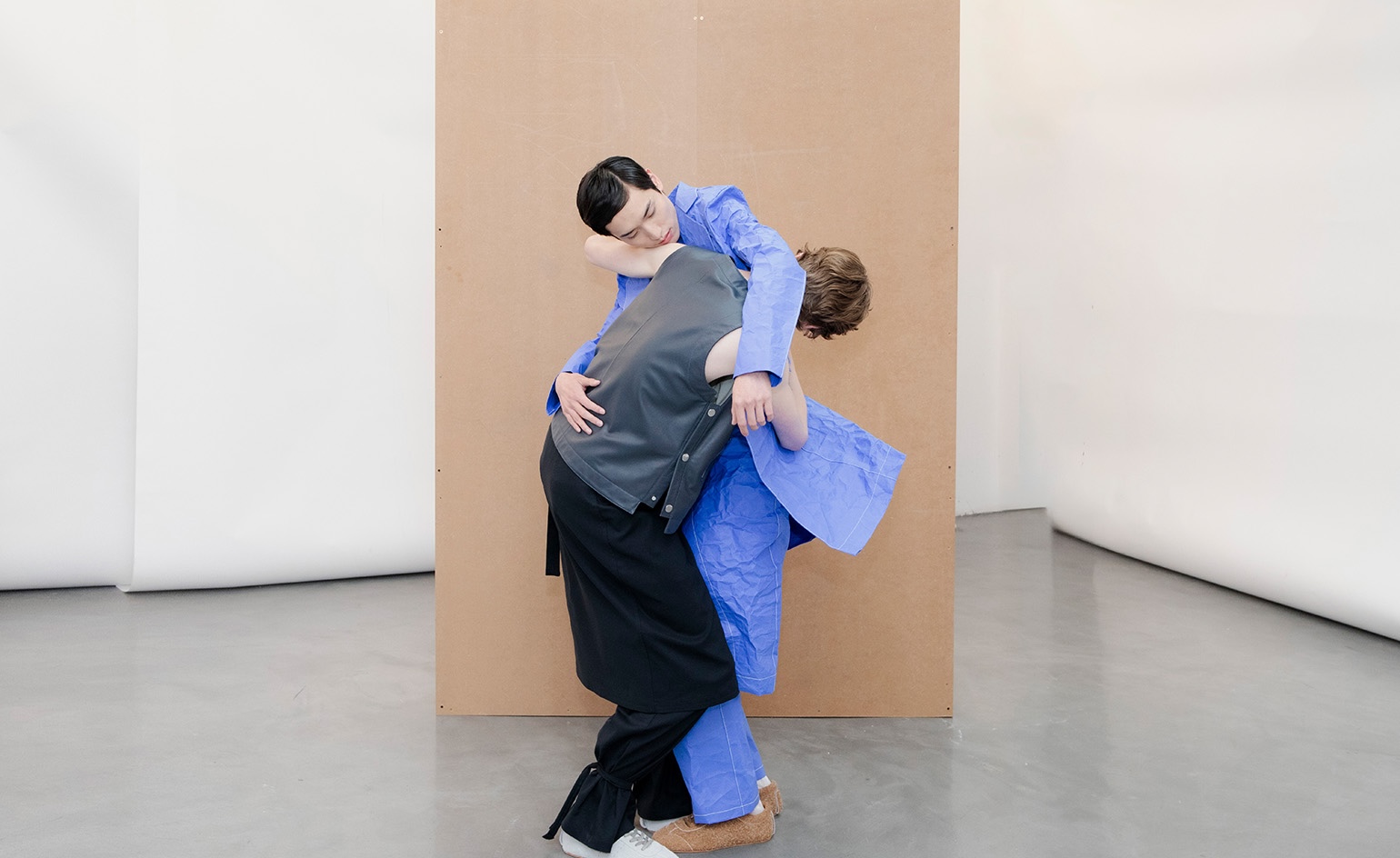 The independent designers you might have missed from fashion month S/S 2026
The independent designers you might have missed from fashion month S/S 2026Amid a tidal wave of big-house debuts, we take you through the independent displays that may have slipped through the cracks – from beautiful imagery to bookshop takeovers, museum displays and moves across the pond
-
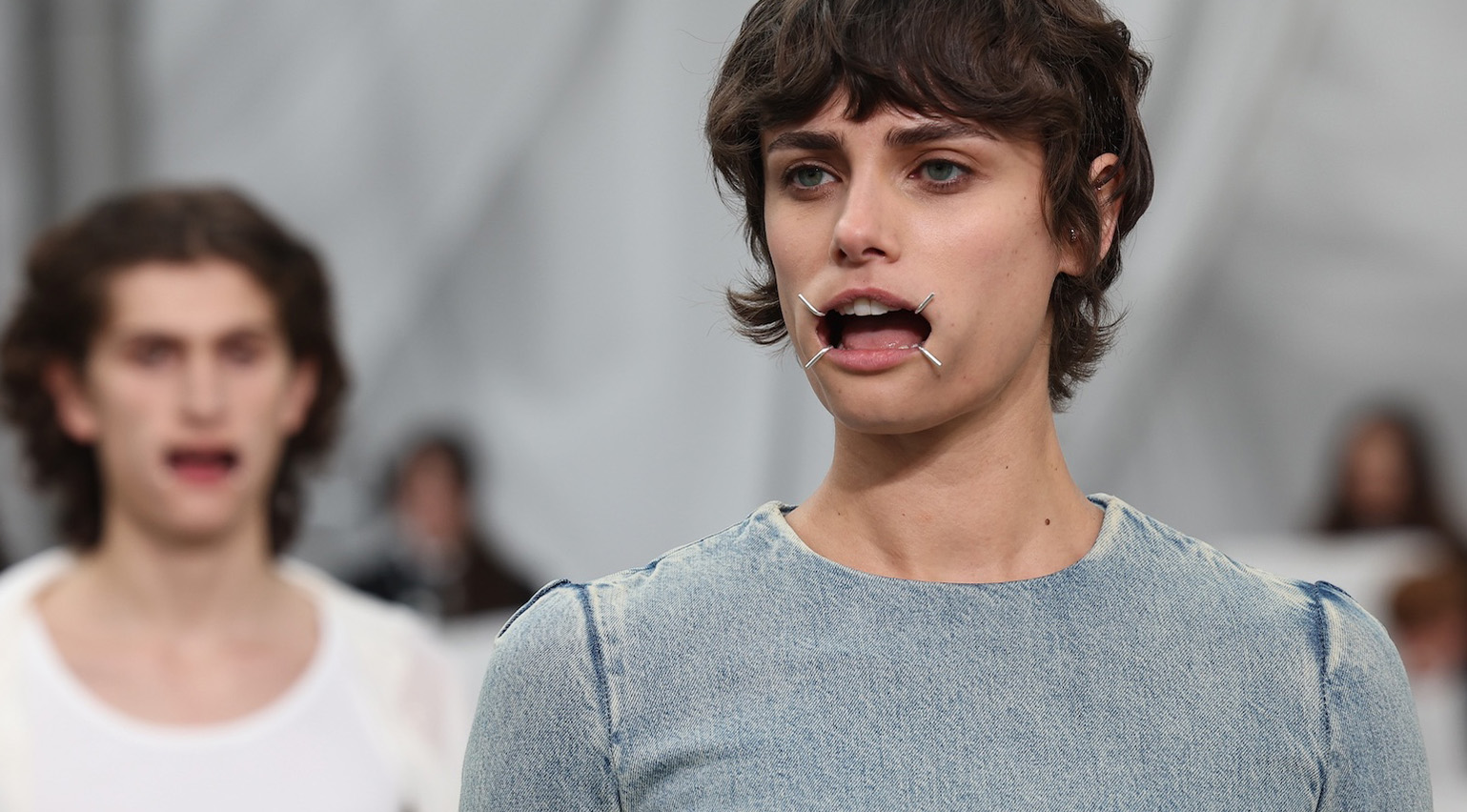 From wearable skincare to scented runways, unpacking the unconventional beauty moments of fashion month S/S 2026
From wearable skincare to scented runways, unpacking the unconventional beauty moments of fashion month S/S 2026The S/S 2026 season featured everything from probiotic-lined athleisure to fragranced runways – and those Maison Margiela mouthguards
-
 Pierpaolo Piccioli makes Balenciaga debut ‘from a place of love and connection’
Pierpaolo Piccioli makes Balenciaga debut ‘from a place of love and connection’Attended by Anne Hathaway and Meghan Markle, the ex-Valentino designer’s first runway display for Balenciaga took place within Kering’s Paris headquarters
-
 Jack McCollough and Lazaro Hernandez make a bold start at Loewe, inspired by Ellsworth Kelly’s ‘elemental colours’
Jack McCollough and Lazaro Hernandez make a bold start at Loewe, inspired by Ellsworth Kelly’s ‘elemental colours’The former Proenza Schouler designers presented their debut collection for Loewe this morning, channelling ‘clarity and colour, sensual physicality, and sunniness’
-
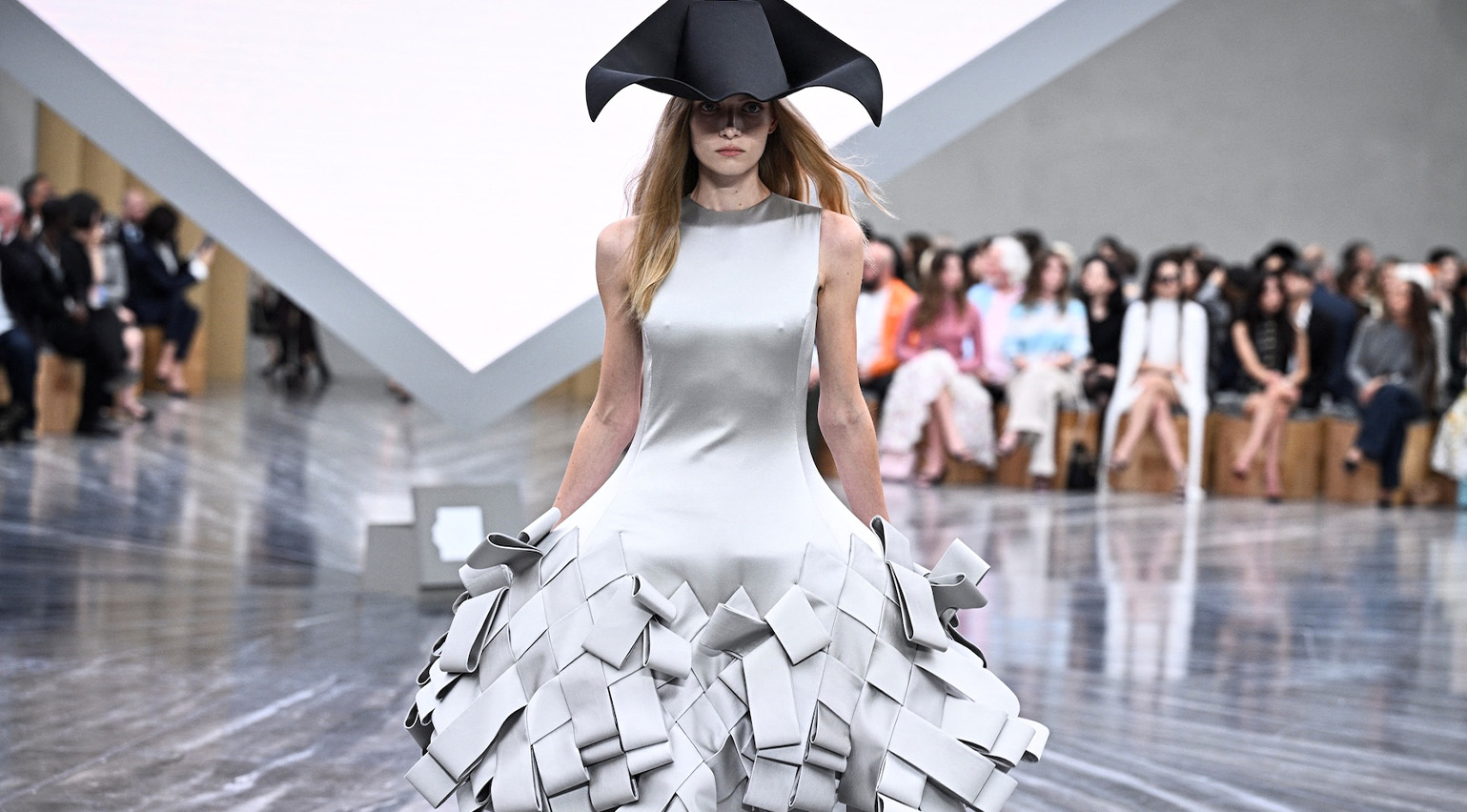 ‘Change is inevitable’: Jonathan Anderson’s first Dior womenswear collection recodes the house’s archive
‘Change is inevitable’: Jonathan Anderson’s first Dior womenswear collection recodes the house’s archiveAn audacious collection from the Northern Irish designer, presented in Paris this afternoon, saw him reconsider the Dior archive in his unwaveringly inventive style